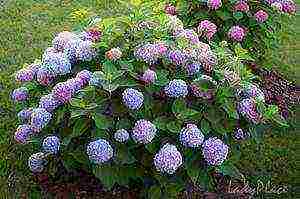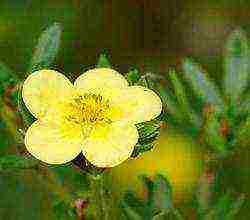Content
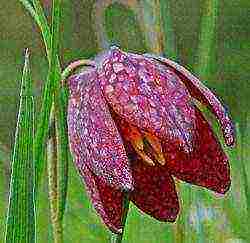 Growing hazel grouse (fritillaria) and caring for them does not present any particular difficulties for gardeners, when planting them in open ground, you just need to carefully choose a place: these flowers love the sun or a little shade, nutritious soil, not very abundant, but regular watering.
Growing hazel grouse (fritillaria) and caring for them does not present any particular difficulties for gardeners, when planting them in open ground, you just need to carefully choose a place: these flowers love the sun or a little shade, nutritious soil, not very abundant, but regular watering.
Grouse: varieties and varieties
Fritillaria - translated from Latin means "glass" or "glass", this name is associated with the shape of the flower - a large, bright, shaped like a glass or a bowl.
The hazel grouse got its popular name - "chessboard" due to the appearance of a "chessboard" perennial in color: its buds look like the cells of a chessboard with a uniform alternation of colors. This variegated variety gave the entire genus fritillaria the Russian name "hazel grouse", from the word "speckled".
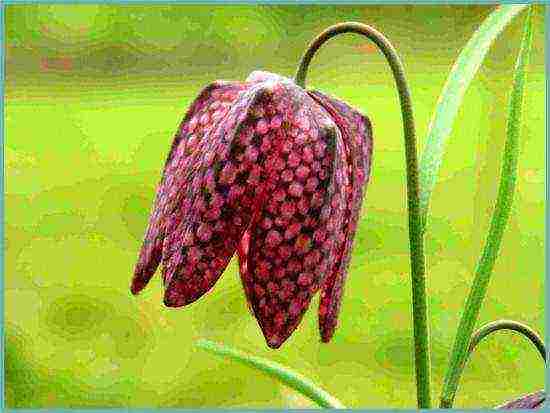
Grouse "checkerboard" - one of the most unusual flowers that are easy to grow by yourself
The varieties of hazel grouses are very numerous, currently about 180 species are known, which mainly grow in European countries with a temperate climate, in western Asia and in the North American states. Reproduction of hazel grouses is carried out vegetatively and by seeds.
Varieties of hazel grouse differ in color of its flowers, in size, in flowering time, among them there are inconspicuous, tiny plants, and there are also gorgeous giant varieties, but the "chess" variety is very popular among amateur gardeners.
- Fritillaria "chess" - refers to small-bulbous perennial plants. This variety of hazel grouse has two varieties - brown-burgundy and white-yellow cells. These varieties are short, growing only up to 15-20 cm in height, with small buds.
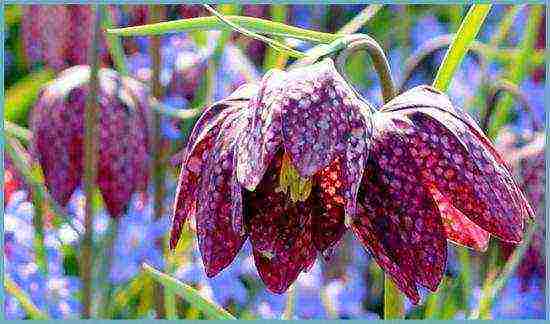
Fritillaria "chess"
- Fritillaria imperial - has a bright color of flowers, reaches a height of 80 cm.
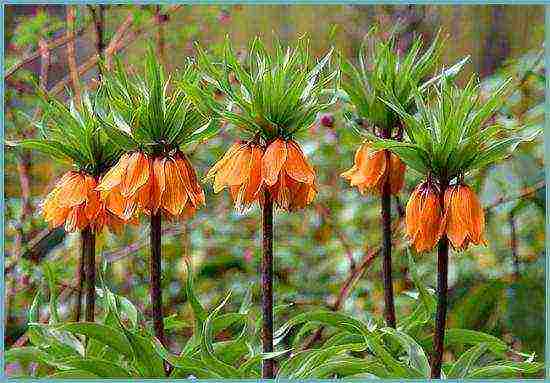
Fritillaria imperial
- Fritillaria needle-petalled - grows well in sun and partial shade, prefers moist soil. Yellow flowers with bright red streaks appear in open field in May.

Fritillaria needle-petalled
- Fritillaria Kamchatka - bright purple glasses of flowers delight gardeners from May to June, but the seeds do not have time to set during flowering.
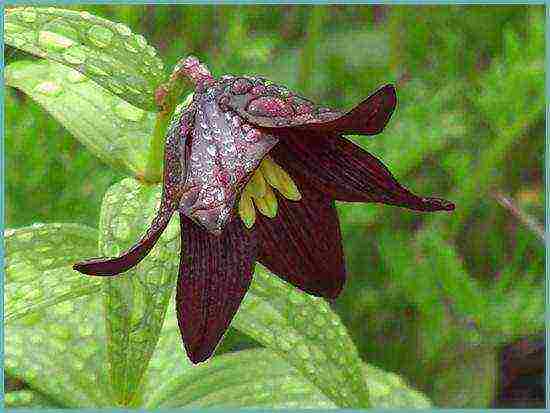
Fritillaria Kamchatka
- Fritillaria persian - a southern flower, but in the middle lane it tolerates the winter well if it is covered with dry leaves. Its delicate yellowish-green buds appear in mid-May, but not every year.
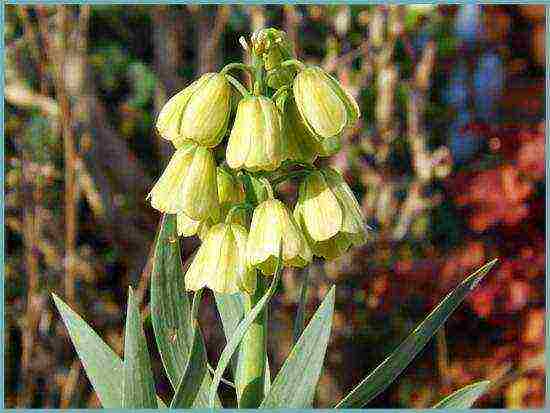
Fritillaria persian
Planting a plant
Like all perennials, sun-loving hazel grouses, planting and caring for which does not require any special effort, prefer fertile, well-drained soil.
Previously, compost or humus is introduced into the planting hole, in proportions - half a bucket of compost per 1 sq. m of plot, then drainage is laid, it can be sand or sifted humus, then a perennial bulb is placed.
When planting, be sure to spread the roots. If the variety is undersized, then the bulb is buried to a depth of 6-10 cm, if tall varieties are planted - to a depth of 30 cm.In groups, the distance between small bulbs is 10-15 cm, between large ones should be at least 30 cm.

Hazel grouse
Growing of some varieties outdoors can be done in slightly shaded areas, for example, hazel grouse grows well in sunny areas and in the shade. Grouse "chess" love that ash or lime was placed in the hole during planting.
Planting fritillaria is carried out at the very beginning of autumn, when roots appear at the bottom of the perennial bulbs, but it is not worth delaying, since the hazel grouses will not have time to bloom in May.
Plant care
The soil around this perennial plant should be covered with peat in order to avoid drying out in the heat, for example, in rockeries or rock gardens. Loosening the ground is not worth it, you can damage the roots located at the surface. After the flower has faded, if seeds are not needed, it must be removed so that the plant does not deplete.
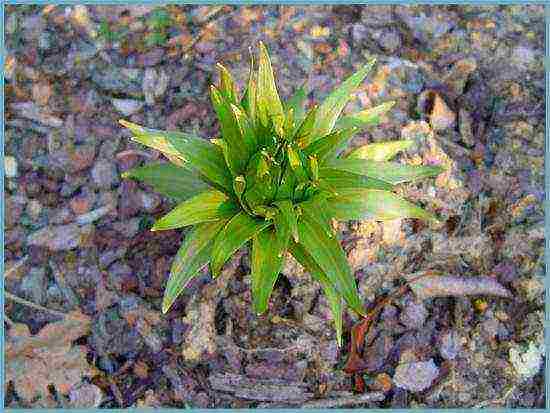
Mulch the soil around the hazel grouse and ensure proper watering
As a rule, in winter, if there is little snow, the plantings of fritillaria are covered with spruce branches or reeds to avoid freezing of the bulbs. However, the varieties of "chess" hazel grouse are quite unpretentious, do not require special care, and they are not very afraid of frost. If you plant them in early September so that they take root well before frost, then you do not need to cover them in winter.
Attention! Delicate "chess" hazel grouse needs a lot of sun. When grown in partial shade, the flower feels bad, blooms little. The flowers will be small even if the crop is properly cared for.
Fertilization and feeding
In early spring, these perennial plants need feeding. Nitrogen-containing fertilizer is applied to the soil in a dry form, and during the period when flowers appear, hazel grouses need to be fed with mineral fertilizer - 1 tbsp. spoon per square meter. Wood ash or chicken droppings can be added in the same proportions.
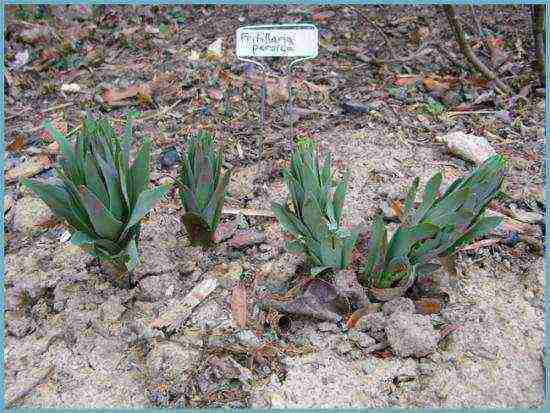
Feed the crop annually before and during flowering
Reproduction of hazel grouse
Reproduction of fritillaria occurs vegetatively, annually planted bulbs are replaced with new ones, and a daughter one is formed. The number of children depends on the type of perennial.
Bulbs of the "chess" variety are dug up and divided not every year; it is enough to do this once every 6-7 years. During this growing period, they do not stop blooming, but the peduncles no longer become. Such large-bulbous varieties as imperial, Persian, pale-flowered varieties are dug every year. Grouse with small bulbs (fox-berry, Mikhailovsky) can not be dug for 3-4 years, while covering with black material to warm the bulbs.
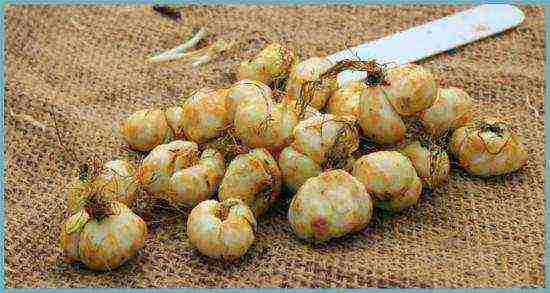
The easiest way to breed hazel grouses is to plant bulbs
If desired, the reproduction of hazel grouses, including "chess" ones, is carried out and from seed... For seed pods to ripen, favorable weather is required; if there is a lot of rain in spring, then the seeds can rot. In a warm place, in the open ground or in a greenhouse, a separate bed is prepared with fertile soil mixed with humus from the foliage. Seeds are planted in grooves, to a depth of 1 cm, the distance between them is 10 cm.On top, the seeds should be sprinkled with a layer of peat up to 2 cm. The cultivation of the bulbs lasts until next year, then, after the leaves dry, they are dug up and stored in a ventilated room until autumn. The bulbs of these perennial plants need to be warmed up at a temperature of about 30 degrees for several weeks in a greenhouse.
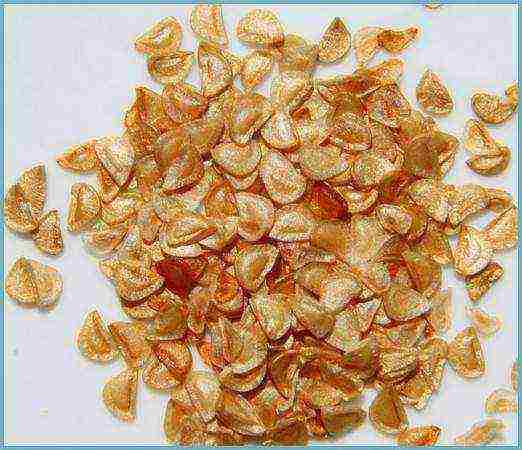
Hazel grouse seeds
The flowering of fritillaria grown from seed begins at 4-5 years, and in large hazel grouses - only at 7-8 years. Watering is moderate, the soil should be moist, but not damp, then it is generally better to reduce watering to 2 times a month. You need to feed the seedlings in the twenties of April and at the beginning of June, after flowering, with complex fertilizers in dry form.
Advice! You should not buy already flowering perennials for planting, they are often sold. Such a hazel grouse, even if it does not die, is very difficult to grow until the next flowering. It is for the "chess" variety that the bulbs are not overdried - the dry ones are no longer viable.
Reproduction of hazel grouse by bulbs gives a good repeatability of varietal traits; with the seed method, this is not always possible to achieve.
Diseases and pests
The hazel grouses are not afraid of pests due to the sharp unpleasant smell of the bulbs; they smell like fresh horse dung. This smell scares off mice, rats and moles.The pest of this perennial is the leaf beetle - a red beetle that eats flowering buds and leaves. It is collected and treated with insecticides. Slugs are also very harmful to hazel grouse, and wireworms can pierce bulbs.
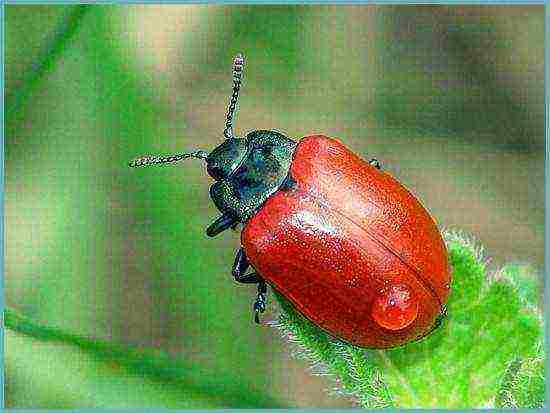
Beetle beetle
Grouse are resistant to diseases, they do not suffer from viral diseases, like tulips and crocuses. Bulbs can rot from cold and wet weather, but rotten places can be cut off and treated with ash, coal, alcohol or even brilliant green, and dried.
The use of fritillaria in landscape design
Grouse varieties "checkerboard" are often used in the landscape design of garden and backyard plots. An ideal place for this variety of hazel grouse due to its low growth on alpine slides and rockeries. In an ordinary flower bed, these delicate "birds" will simply get lost.
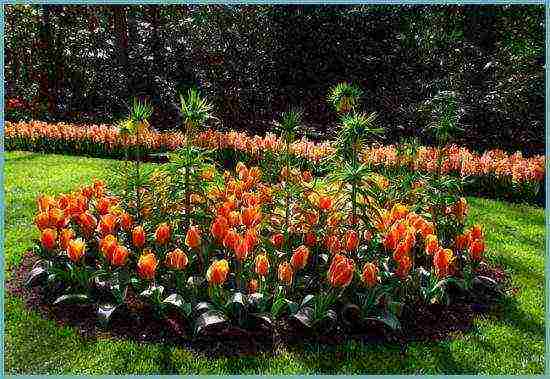
Grouse combined with tulips
Varieties of "checkerboard" hazel grouse can be used to decorate the lawn, planting them in separate islands, but it is impossible to mow such a lawn until the end of flowering, the hazel grouse will stop blooming. The neighbors of these checkered flowers used in landscaping gardens can, in principle, be other low perennial flowers that require less intensive watering, for example, phlox or primroses. A variety of photos of landscape compositions with the participation of chess flowers can be found in electronic and printed publications.
Other species, taller, such as Persian hazel grouse, fit well into the composition of the garden in group plantings with tulips, anemones, crested crestedlings - along the paths and in the flower beds. And the combination of imperial hazel grouse with undersized shrubs, conifers and climbing perennials is actively used in landscape design when creating mixborders and ridges.
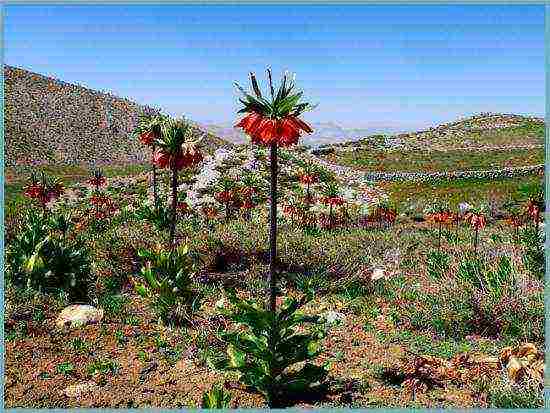
Grouse in landscape design
In conclusion, we can say that speckled flowers have been pleasing to the eye in gardens for a very long time, nevertheless, for some gardeners these perennial bulbs do not bloom, but it is not the flowers that are to blame, but the owners of the garden, who do not take into account the simple features of growing this rather unpretentious plant.
Planting hazel grouse: video
Grouse species: photo
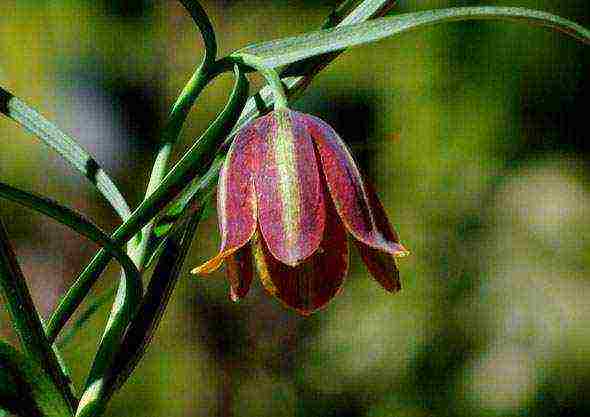
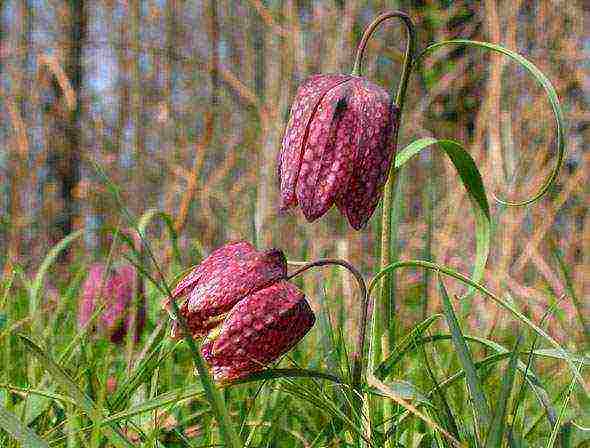
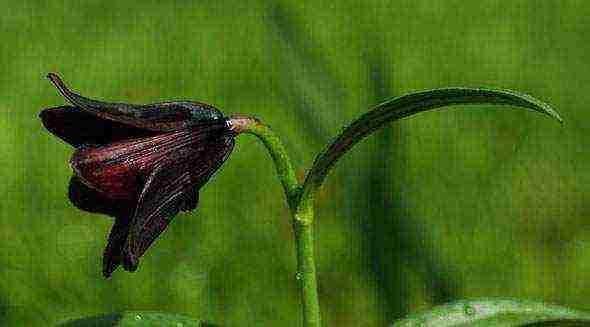
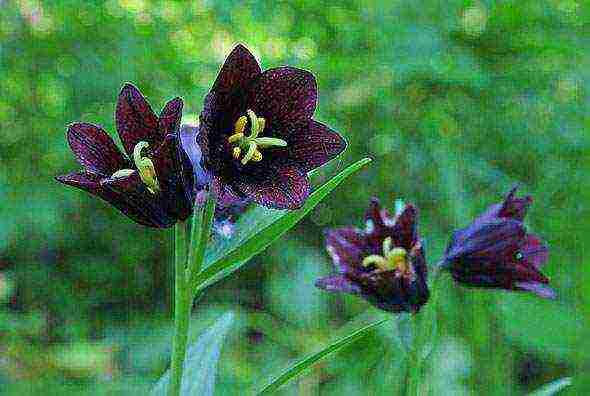
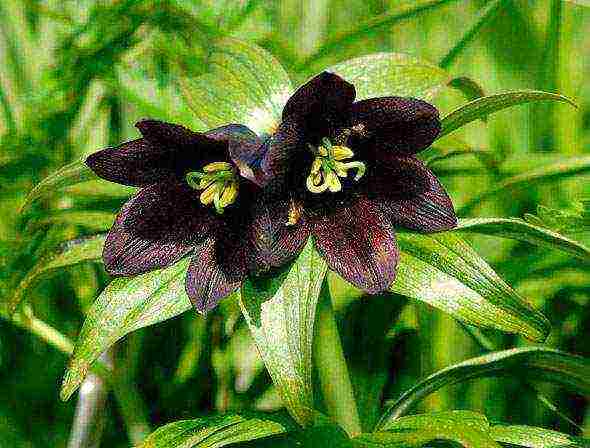
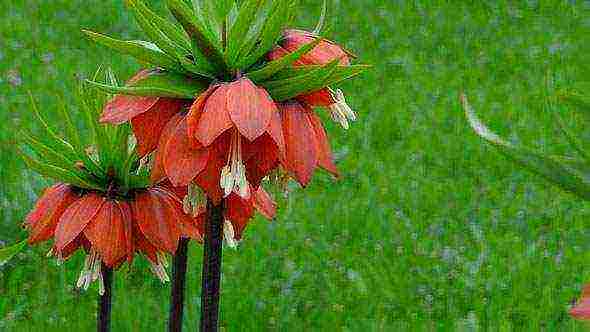
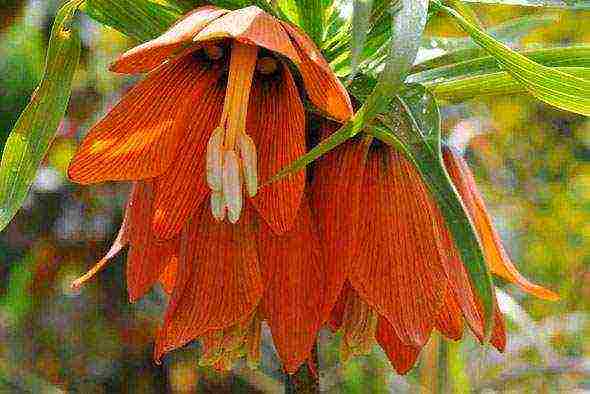
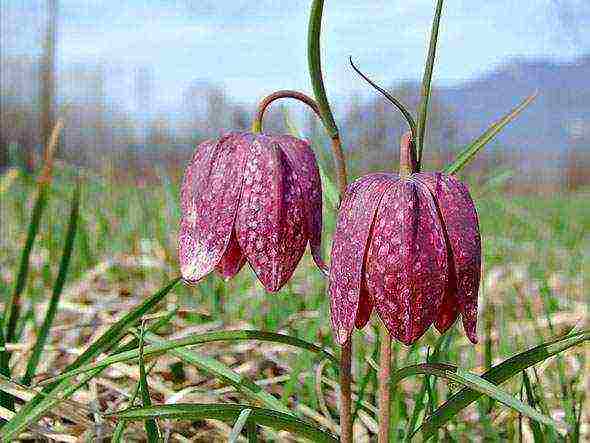
In Latin, fritillaria is designated as "hazel grouse", in common people it is called "royal crown". Regardless of the name and variety, fritillaria can be called one of the brightest and most fragrant representatives of the floral world.
A tall and stately plant will be a great addition to the design of a flower bed or garden. The fritillaria flower will not leave indifferent any gardener, and the cultivation of the "royal crown" will not be difficult, since the hazel grouse, the flower is unpretentious and gets along well with neighbors in the garden.
The content of the article:
- Fritillaria landing
- Fritillaria flower care
- Fritillaria varieties
- Fritillaria "Rubra"
- Fritillaria "Grouse"
- Fritillaria "Aurora"
- Fritillaria "Imperial"
- Fritillaria "Meleagris" and "Uva Vulpis"
- Fitillaria "Lutea"
- Fritillaria "Radde"
- Fritillaria "Striped Beauty"
- Fritillaria "Persian" (black)
- Fritillaria "William Rex"
- Fritillaria variety "Mikhailovsky"
- Fritillaria needle-petaled "Akmopetala"
- Fritillaria "Raskal Bach"
- Fritillaria "Garland Star"
- Secrets of the lush bloom of fritillaria
Fritillaria landing
The correct organization of autumn planting and care of the fritillaria flower, as well as timely control over the plantings, will reward you in the spring with fragrant, lush flowering and a colorful picture of bright hazel grouse buds.
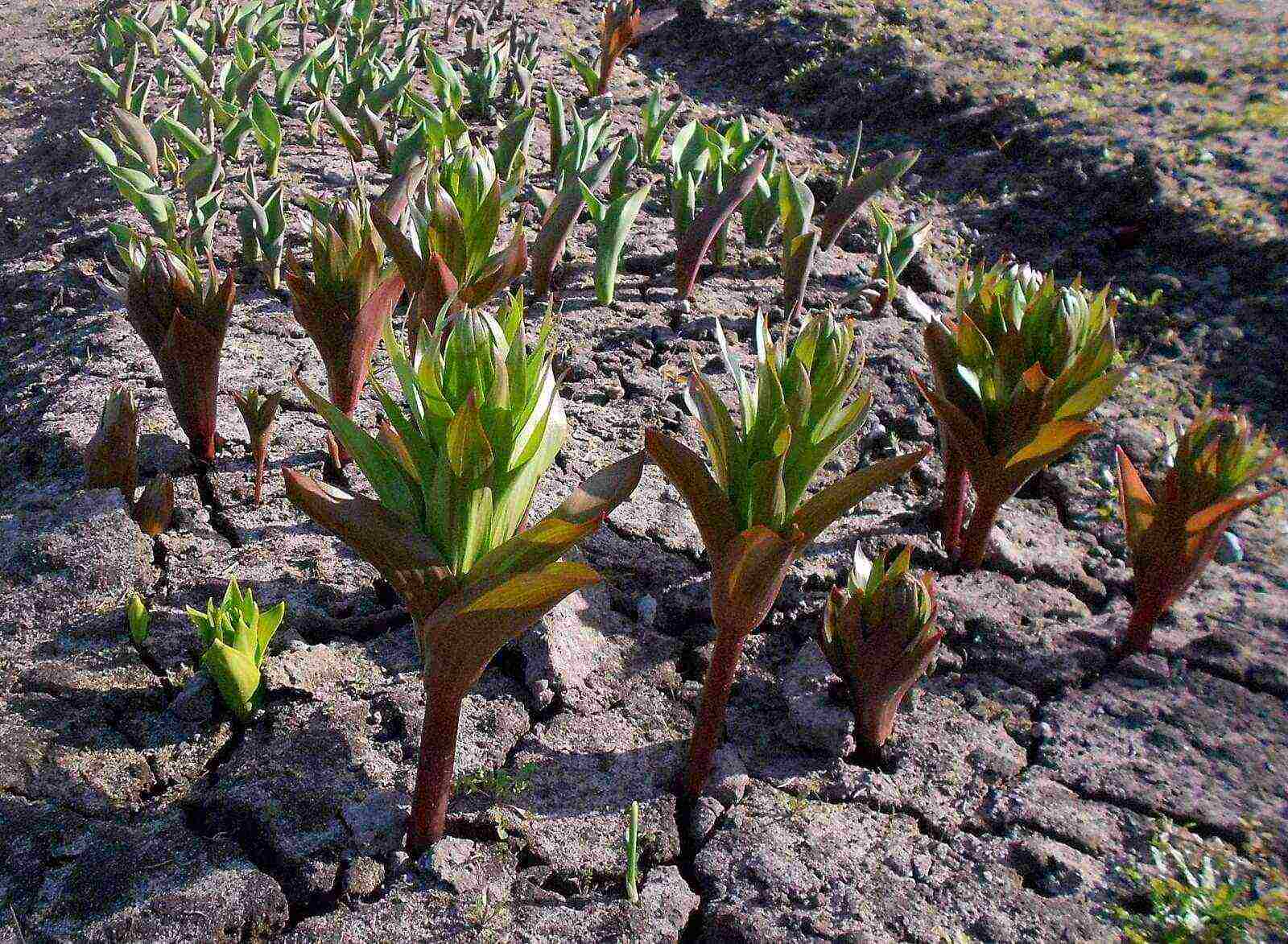 Fritillaria is in demand among most flower growers, for the variety of color palette of inflorescences and relative unpretentiousness.
Fritillaria is in demand among most flower growers, for the variety of color palette of inflorescences and relative unpretentiousness.
Fritillaria is a colorful representative of the lily family and has about a hundred varieties of its species. Therefore, the choice of a suitable variety of hazel grouse, specifically for your site, will not be difficult.
Fritillaria prefers fertile soil, with an average pH level, not clogged, loose and aerated. The site for planting should be well lit, but with variable solar activity.In too shaded areas, fritillaria will stretch upward, depriving the buds of nutrients, and this will affect the size and color of the inflorescences.
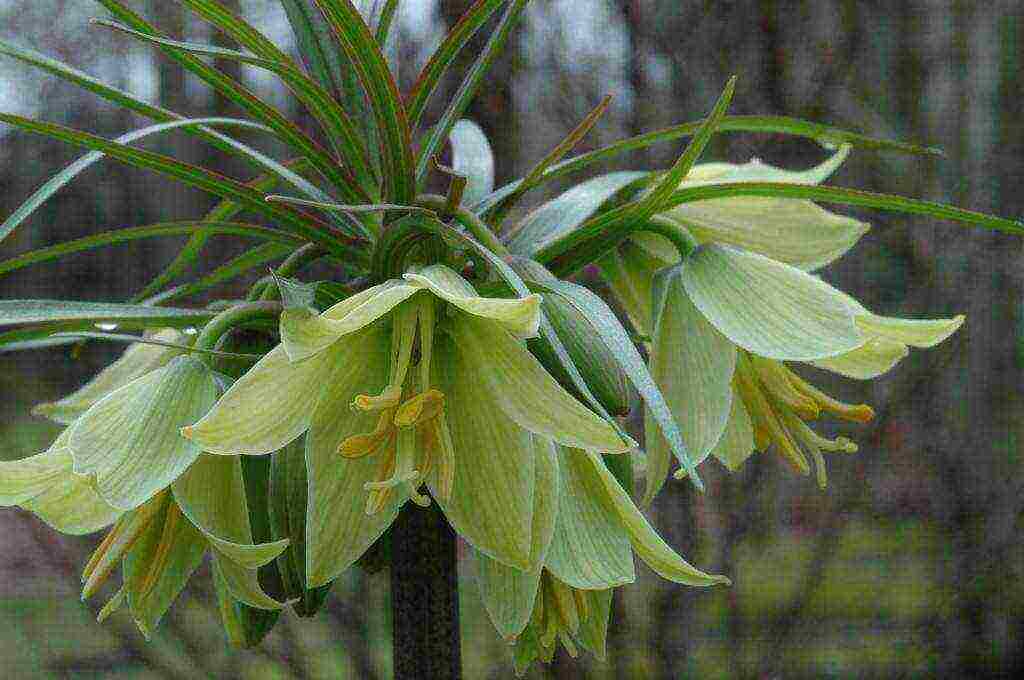 If your site for planting hazel grouse does not meet the above requirements, do not be upset. The scarcity of soil is easy to fix, for this you need to prepare the site in advance. Having dug up the soil at least on a shovel bayonet, apply organic fertilizers 5 buckets for every 5 square meters. m. of land.
If your site for planting hazel grouse does not meet the above requirements, do not be upset. The scarcity of soil is easy to fix, for this you need to prepare the site in advance. Having dug up the soil at least on a shovel bayonet, apply organic fertilizers 5 buckets for every 5 square meters. m. of land.
Planting fritillaria begins in late August, early September, but not later, since the bulb must take root and have time to gain strength for the upcoming release of the peduncle.
Fritillaria is a large, weighty plant; with a thick, fleshy, high peduncle, so the planting depth should be at least 25 cm. If the soil of your plot is "clogged" or heavy, shallow planting of the bulb up to 25 cm will facilitate germination. But, the best solution would be to "lighten" such a soil, for this add sand (bucket per 1 sq. M.) And peat (1.5 buckets per sq. M.) Into the soil and dig it up.
To correctly calculate the planting depth of the fritillaria bulb, multiply the diameter of the bulb by three.
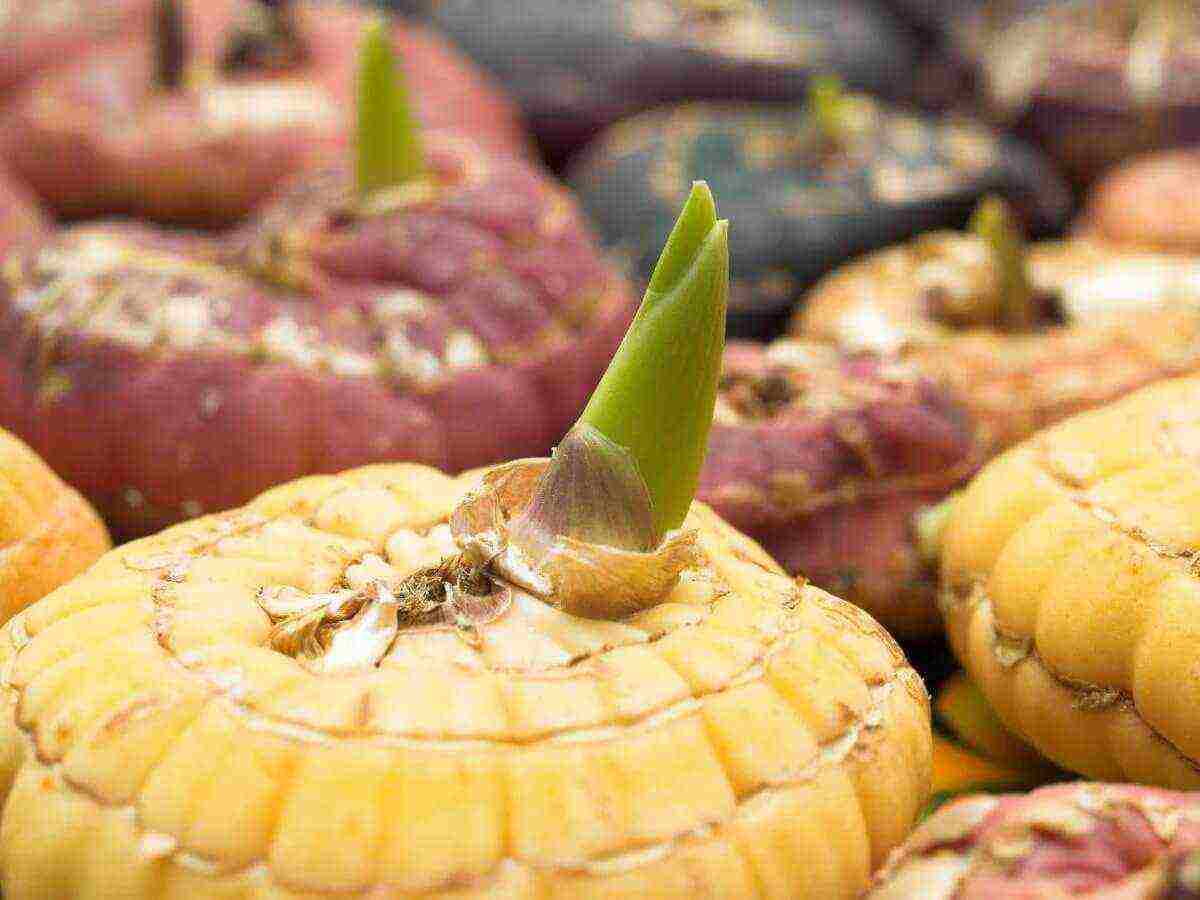 Before planting, fritillaria bulbs are examined, damaged and suspicious areas are cut off, soaked for several minutes in a solution of potassium permanganate, dried, sprinkling the slices with activated carbon or ash, then planted.
Before planting, fritillaria bulbs are examined, damaged and suspicious areas are cut off, soaked for several minutes in a solution of potassium permanganate, dried, sprinkling the slices with activated carbon or ash, then planted.
The wells for planting fritillaria must be formed so that the flowers do not interfere with each other, the observance of a distance between plants of 30 cm will be sufficient. The depth of the hole varies from 25 cm on heavy soils and 35 cm on light soils. A centimeter layer of sand is laid at the bottom of the hole, which will serve as drainage, the soil is abundantly moistened, then the bulb is laid and sprinkled with fertilized soil.
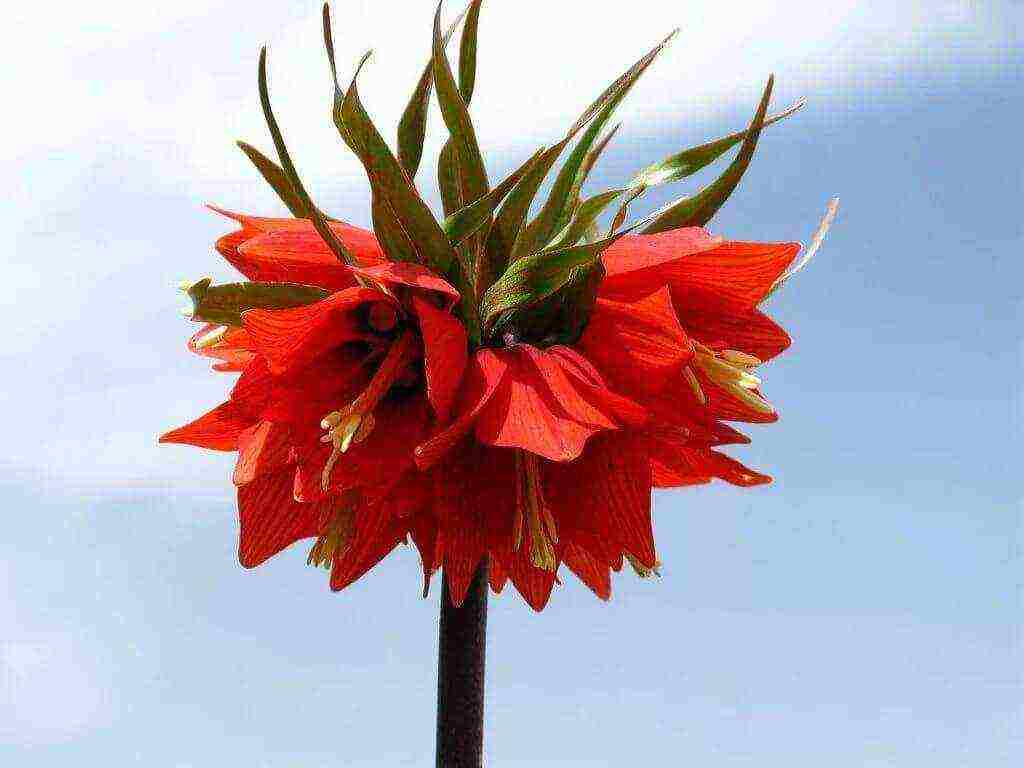 The future flowering and reproduction of the plant will depend on the depth of planting of the fritillaria bulb. The larger the bulb, the deeper the embedding. For fritillaria, a balanced level of soil acidity is required, the flower will not grow on acidic soils, the same applies to swampiness, hazel grouse does not tolerate stagnation of water.
The future flowering and reproduction of the plant will depend on the depth of planting of the fritillaria bulb. The larger the bulb, the deeper the embedding. For fritillaria, a balanced level of soil acidity is required, the flower will not grow on acidic soils, the same applies to swampiness, hazel grouse does not tolerate stagnation of water.
Before planting, think in advance about the dispersion of flowers over the site, fritillaria blooms all spring, and then dies off, so it would be better to plant hazel grouse bulbs nearby with other flowers so that the flower bed does not seem empty.
Fritillaria flower care
Caring for fritillaria in the open field does not require significant effort, and includes the main agrotechnical measures: weeding, hilling, watering, fertilizing. And in connection with the botanical distinctive feature of fritillaria, to absorb moisture not only from the soil, but also from the atmosphere (due to the structure of the leaves) minimizes the frequency of watering.
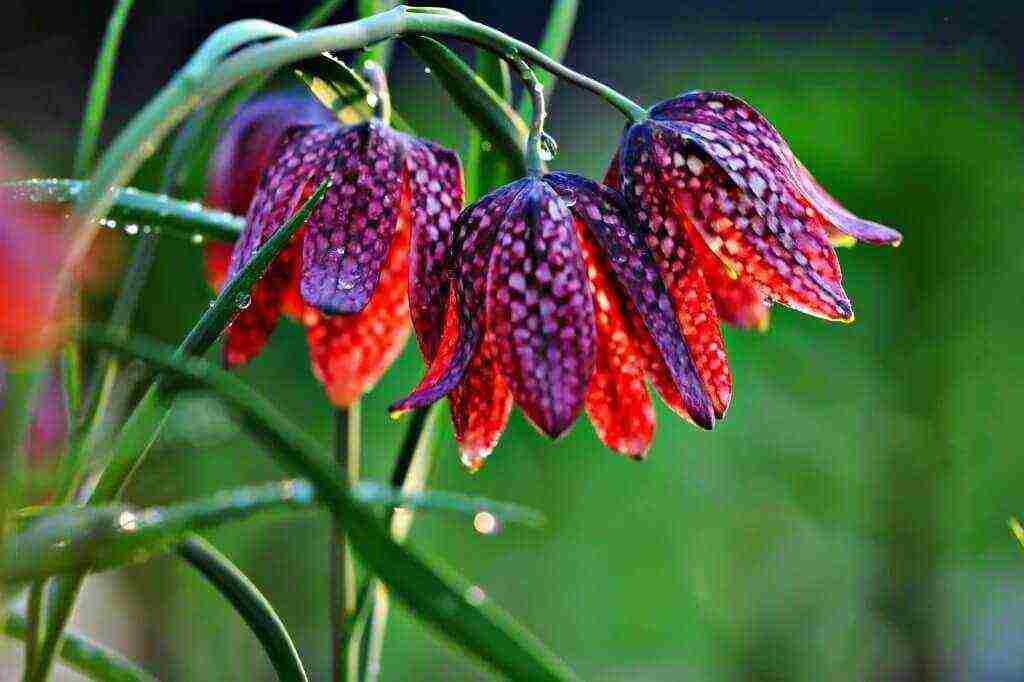 Fritillaria is an unpretentious plant with great potential for luxurious flowering. But in order for the "royal crown" to please you with large inflorescences, the minimum application of fertilizers is still necessary.
Fritillaria is an unpretentious plant with great potential for luxurious flowering. But in order for the "royal crown" to please you with large inflorescences, the minimum application of fertilizers is still necessary.
Fertilization is carried out twice, before flowering and after, so that the bulb gains strength and prepares for wintering. Before fritillaria bloom, add nitrophoska or phosphorus-potassium fertilizers, water it, and after a few days add ash.
Loosening is required when the plant is just beginning to break through, and also, if you notice that the soil is crusty, once every two weeks will be sufficient for fritillaria to develop.
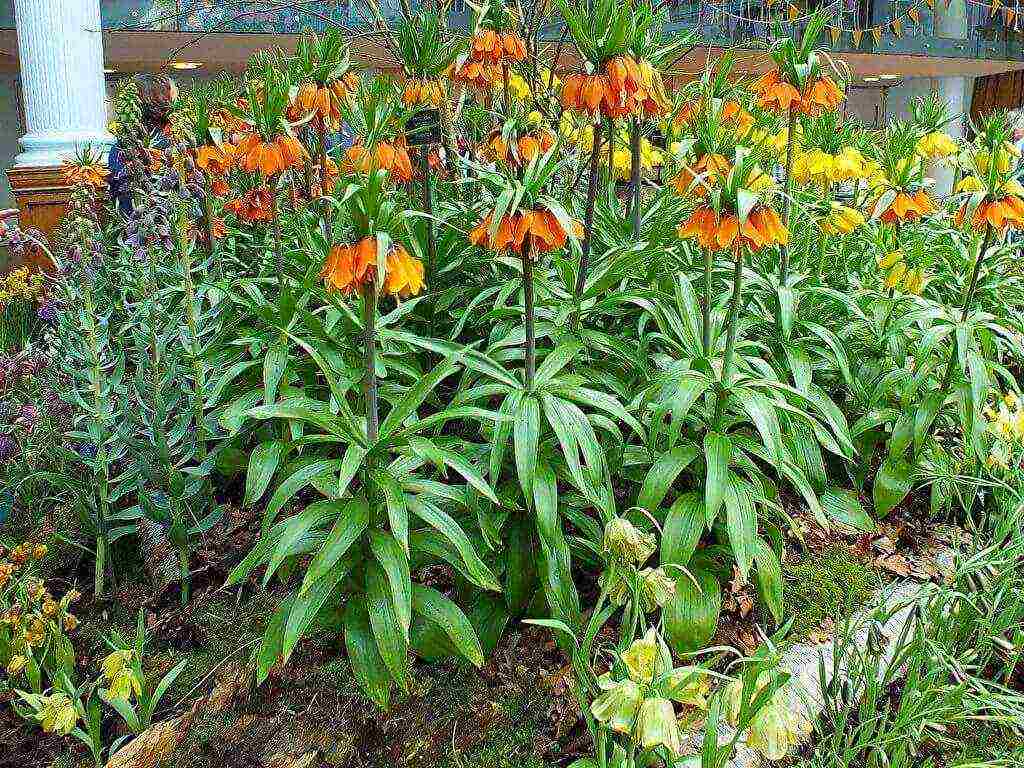 Watering is done once a week, in dry areas and on light soils twice.
Watering is done once a week, in dry areas and on light soils twice.
After the hazel grouse has faded, the peduncle is cut off, and a week later (after drying) the foliage is cut off, fritillaria is fertilized with phosphorus and potassium and watering stops. In the harsh winter, the "royal crown" is covered with mulch.
Fritillaria is resistant to diseases and attacks of harmful insects; it even repels some pests with its specific aroma.
Reproduction of fritillaria occurs both vegetatively and by seeds.Fritillaria seeds are small, ripen in a seed box, formed immediately after flowering.
After the walls of the capsule have dried, the seeds can be harvested. However, sowing hazel grouse is a painstaking and difficult occupation, since such a flower will bloom only four years later, after the formation of the bulb.
Seeds are sown in spring, in warm, fertilized soil, so that the seedlings can grow stronger for winter, with a seeding depth of 2 cm.
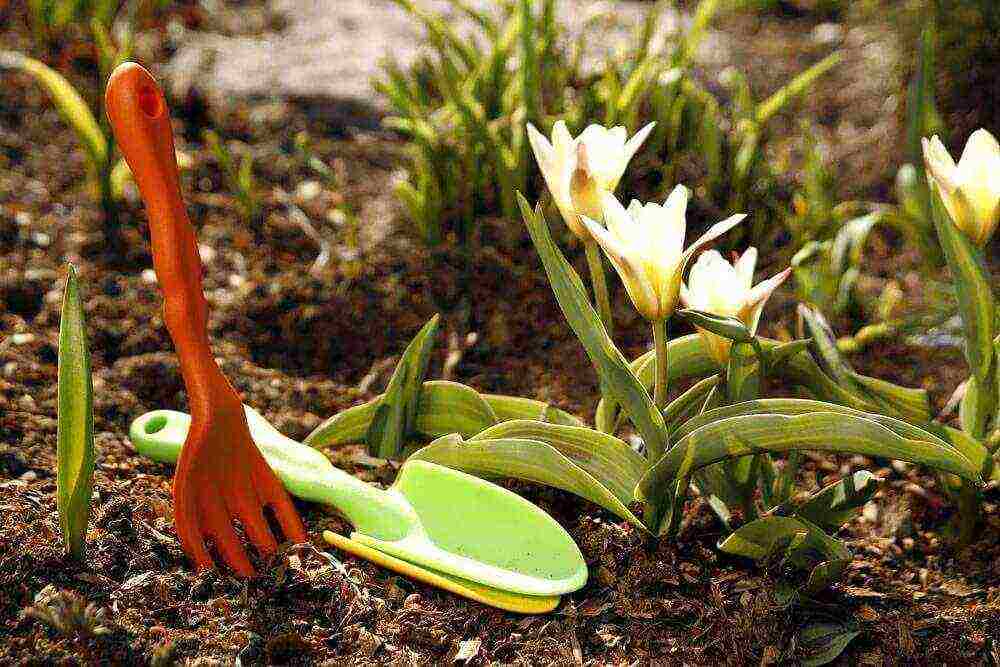 It is better to sow fritillaria in indoor conditions or in a greenhouse, wait until the plant gets stronger and forms a bulb, and then, after vernalization, plant hazel grouse in open ground.
It is better to sow fritillaria in indoor conditions or in a greenhouse, wait until the plant gets stronger and forms a bulb, and then, after vernalization, plant hazel grouse in open ground.
The vegetative way of reproduction of fritillaria occurs by division (formation of babies) of the mother's flower bulb. Transplanting new "babies" in the first year should not be done, it is necessary to give the young bulb to learn to live independently, to acquire a sufficient number of roots.
The optimal time for transplanting fritillaria is the first decade of autumn, during this period, produce and separate two-year-old babies from the mother's bulb, they are easily disconnected and there are no problems with transplantation.
Fritillaria varieties
Fritillaria has become known to the world since the 18th century; Central Europe is considered the birthplace of hazel grouse. More than one hundred varieties of the "royal crown" are grown today all over the world.
Initially, the hazel grouse had an orange color and small inflorescences, but the work of breeders has brought the flower to perfection, and the current varieties of fritillaria are striking in their beauty and diversity.
Fritillaria "Rubra"
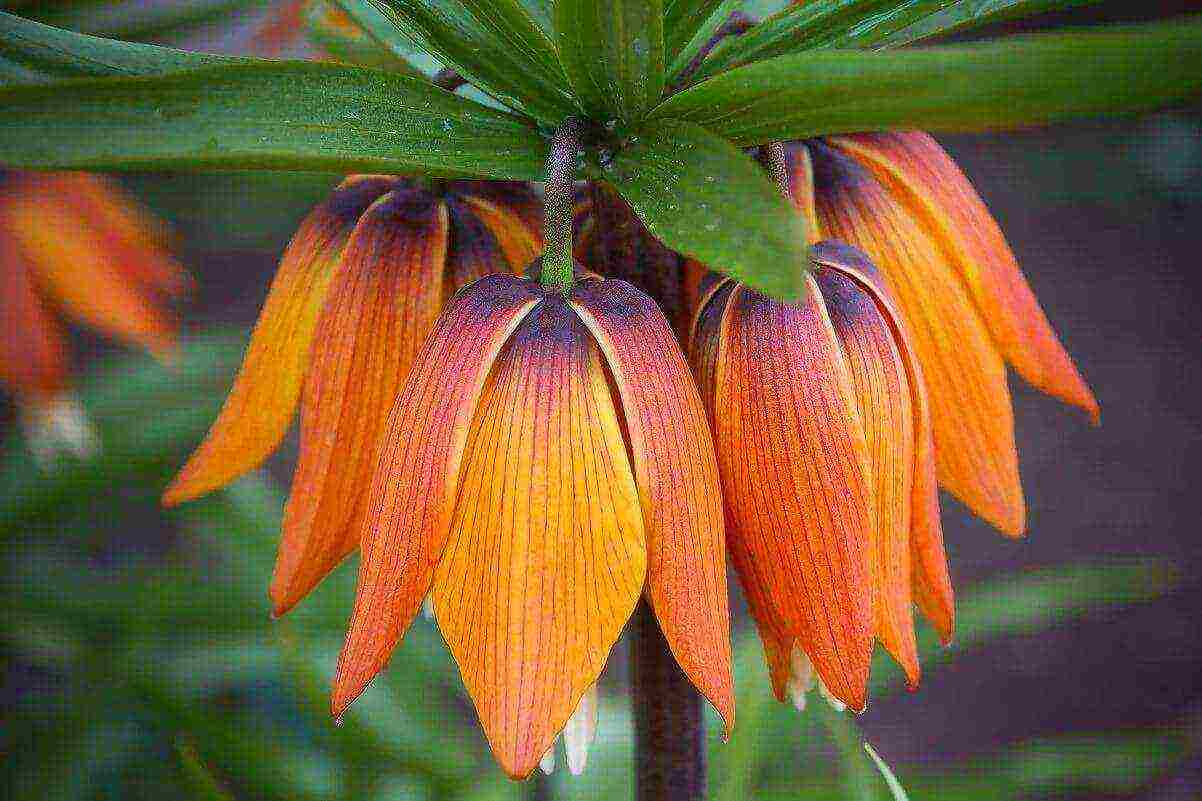 Perennial fritillaria "Rubra" has large scarlet inflorescences, emerald green leaves. Height is about 75 cm. It blooms up to three weeks, abundantly and colorfully, after "Rubra" it throws out the seed box and goes into a dormant state. Propagated vegetatively (by children) and seeds. Rubra fritillaria variety does not require special care. Suitable for both outdoor planting and potting.
Perennial fritillaria "Rubra" has large scarlet inflorescences, emerald green leaves. Height is about 75 cm. It blooms up to three weeks, abundantly and colorfully, after "Rubra" it throws out the seed box and goes into a dormant state. Propagated vegetatively (by children) and seeds. Rubra fritillaria variety does not require special care. Suitable for both outdoor planting and potting.
Fritillaria "Grouse"
The variety belongs to perennial, bulbous. It has a strong, high stem, narrow dark green leaves, large, elongated, drooping flowers.
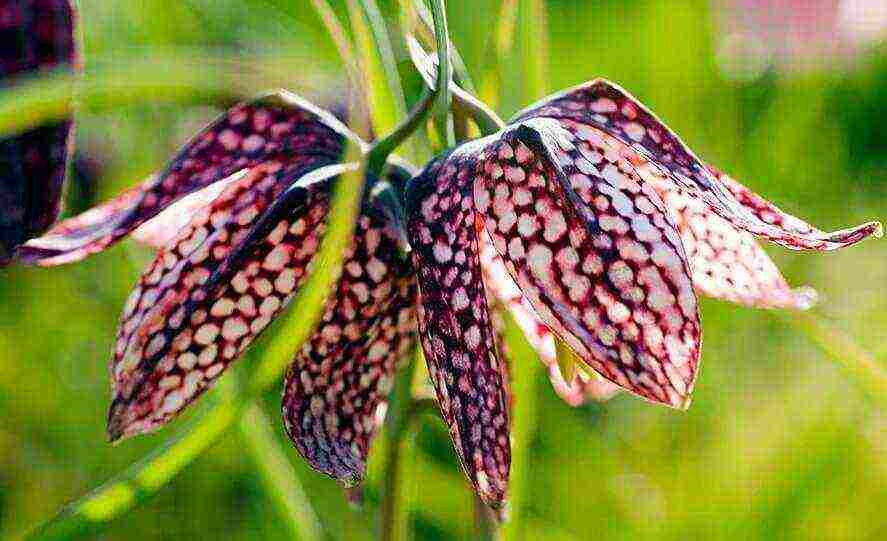 Inflorescences bloom almost simultaneously, with an interval of a day.
Inflorescences bloom almost simultaneously, with an interval of a day.
The flowers are bright orange in color, depending on the variety, they are spotty or with large veins. Flowering begins in May and lasts up to three weeks. Grouse prefers shaded areas and fertile soil. The flower multiplies quickly, without leaving and planting it quickly runs wild. The most prominent representatives of the variety can be called: Imperial hazel grouse, Kamchatsky, Caucasian, Russian, Mars, Orion, Aphrodite.
Fritillaria "Aurora"
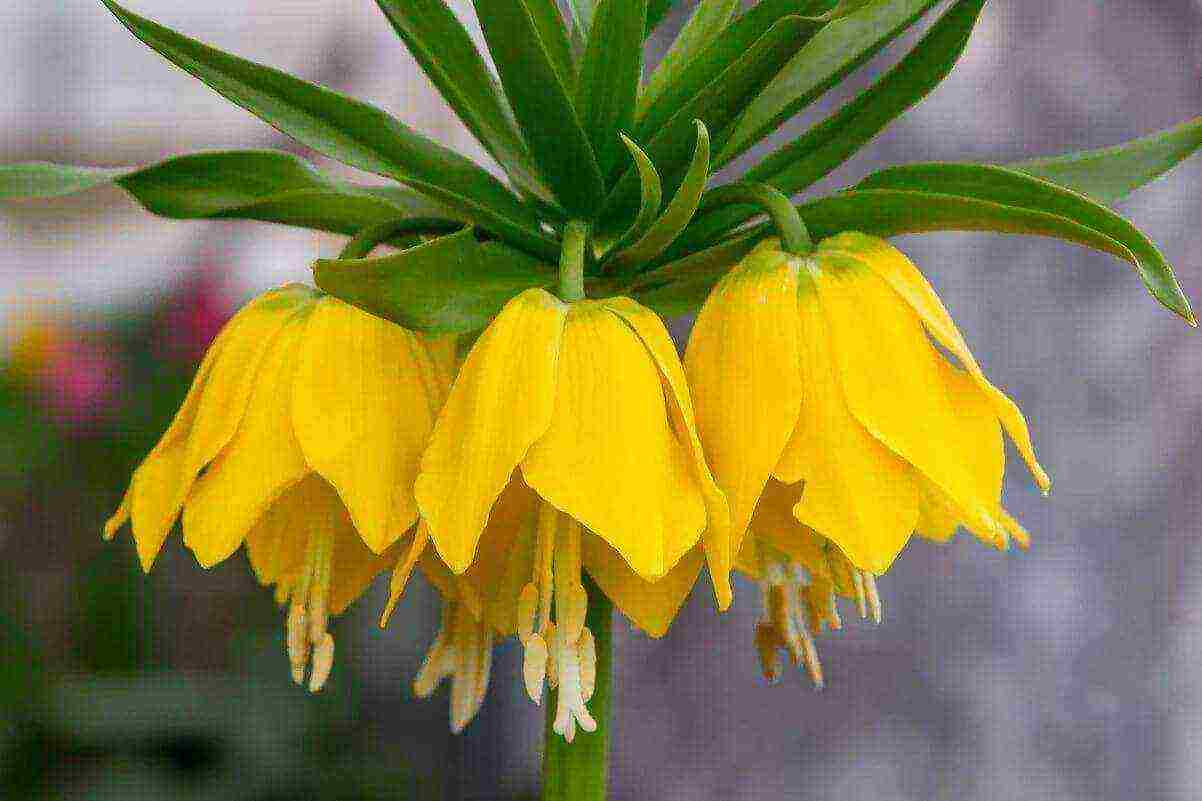 The "Aurora" variety is a perennial fritillaria. The inflorescences are similar to a lush "cap" of an orange-golden hue. The foliage of the plant is bright green. The height of the fritillaria "Aurora" is about a meter. Flowering lasts from three weeks to a month. Unpretentious and incredibly beautiful fritillaria will adorn any flower bed.
The "Aurora" variety is a perennial fritillaria. The inflorescences are similar to a lush "cap" of an orange-golden hue. The foliage of the plant is bright green. The height of the fritillaria "Aurora" is about a meter. Flowering lasts from three weeks to a month. Unpretentious and incredibly beautiful fritillaria will adorn any flower bed.
Fritillaria "Imperial"
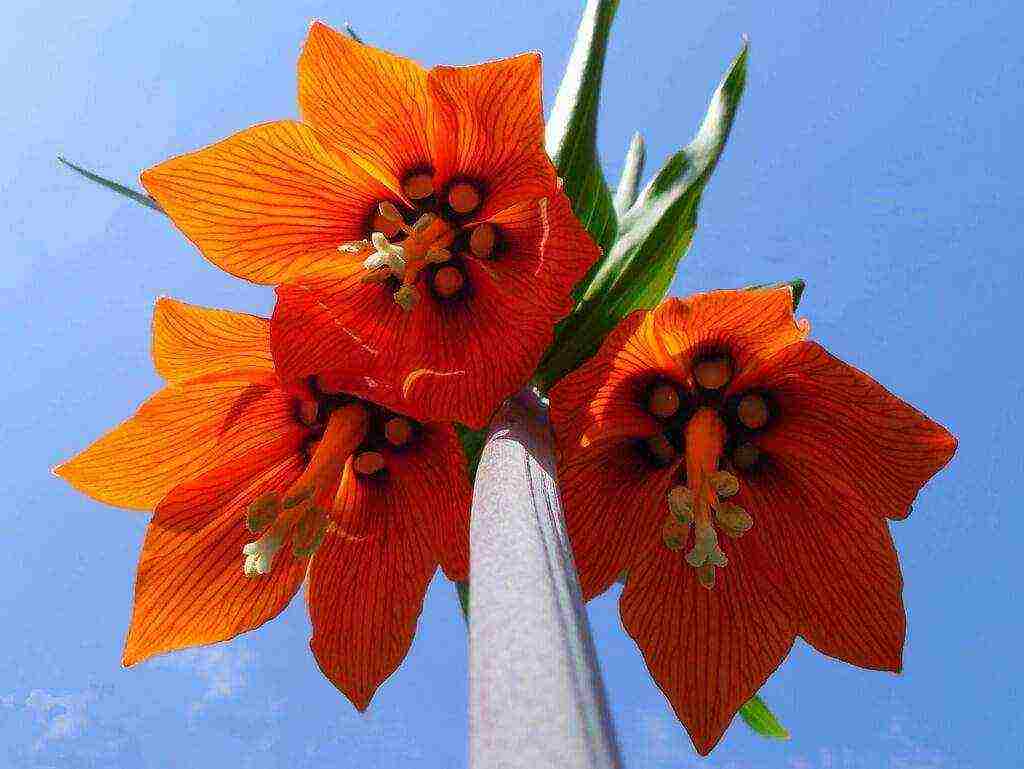 One of the largest inflorescences and buds is the "Imperial" fritillaria. It was this variety that was first called the "royal crown". The inflorescences are collected in a tight lush crown from bright orange to scarlet, a kind of a crown of leaves is located above the inflorescences. Unpretentious variety, blooms from May to June. Reaches up to a meter in height. Will be a great addition to any flower arrangement.
One of the largest inflorescences and buds is the "Imperial" fritillaria. It was this variety that was first called the "royal crown". The inflorescences are collected in a tight lush crown from bright orange to scarlet, a kind of a crown of leaves is located above the inflorescences. Unpretentious variety, blooms from May to June. Reaches up to a meter in height. Will be a great addition to any flower arrangement.
Fritillaria "Meleagris" and "Uva Vulpis"
Fritillaria "Uva Vulpis" belongs to the Assyrian species, is one of the most beautiful varieties. It blooms with large maroon inflorescences, the inner part of the bud is olive shade.
A flower of average height about 65 cm, with lush long foliage.
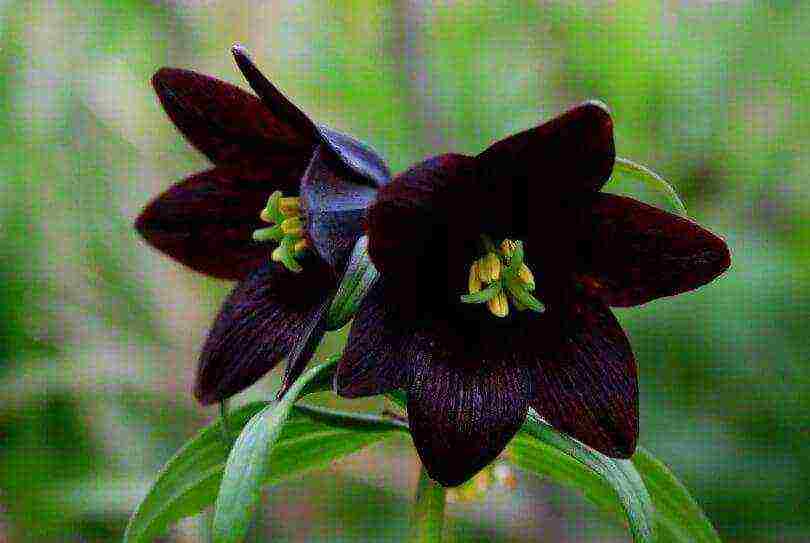 "Variegated" and "Meleagris" variety belong to the chess type of fritillaria. They are distinguished by bright, graphic and memorable color of the petals. The stunted, sparsely deciduous stem reaches a height of up to half a meter."Meleagris", despite its unusual color, does not require painstaking care, grows well in any garden, but without attention it quickly runs wild and becomes shallow.
"Variegated" and "Meleagris" variety belong to the chess type of fritillaria. They are distinguished by bright, graphic and memorable color of the petals. The stunted, sparsely deciduous stem reaches a height of up to half a meter."Meleagris", despite its unusual color, does not require painstaking care, grows well in any garden, but without attention it quickly runs wild and becomes shallow.
Fitillaria "Lutea"
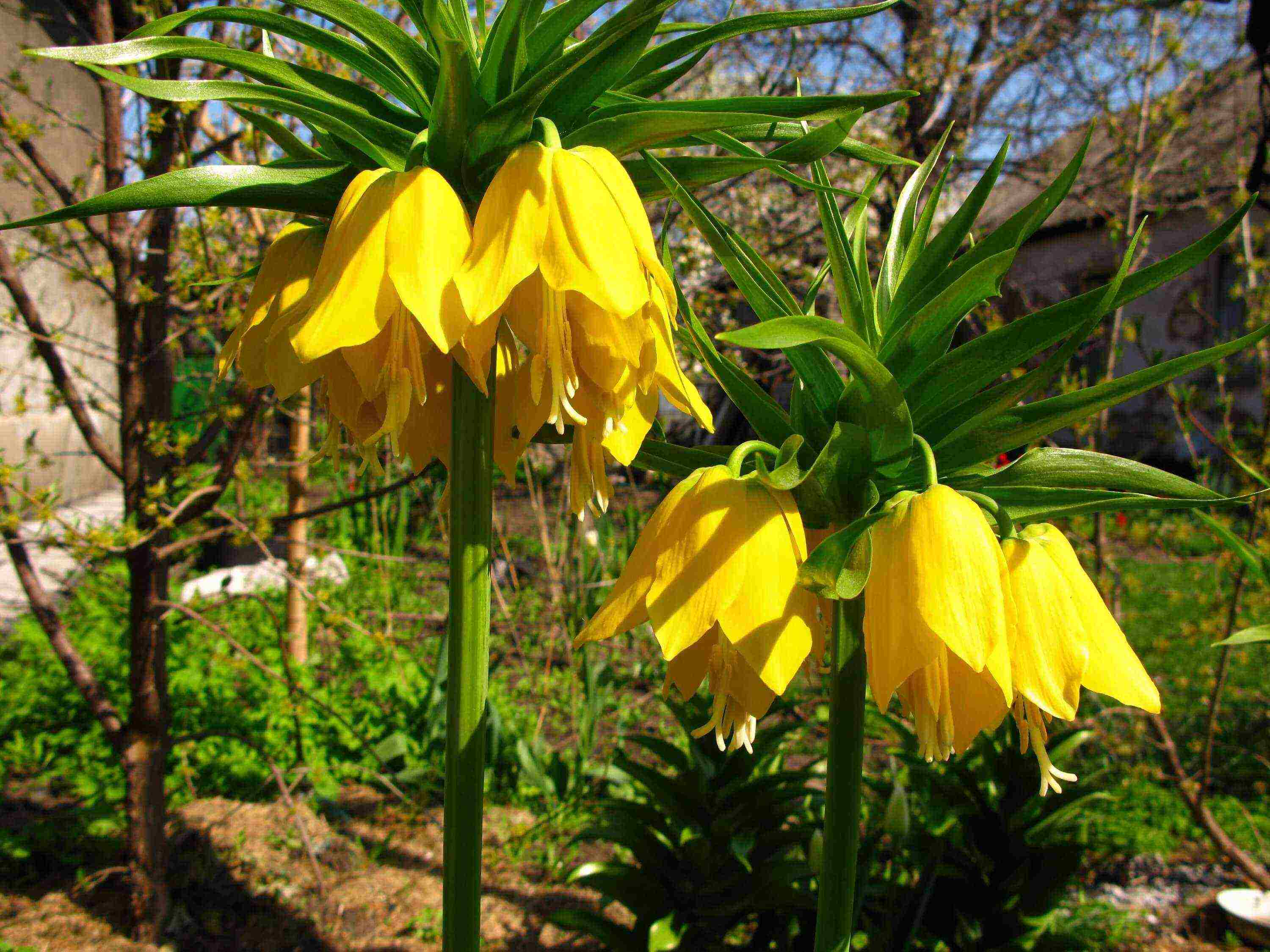 The variety is perennial, bulbous, with bright large yellow flowers. The leaves are green, the height of the stem reaches a meter in length.
The variety is perennial, bulbous, with bright large yellow flowers. The leaves are green, the height of the stem reaches a meter in length.
Reproduction occurs as in the above varieties. The flowering period lasts up to three weeks.
Fritillaria "Radde"
"Radde" is the most beautiful variety of fritillaria, flowering lasts about three weeks, with large wide inflorescences of a delicate yellow-green color. Leaves are thin, long 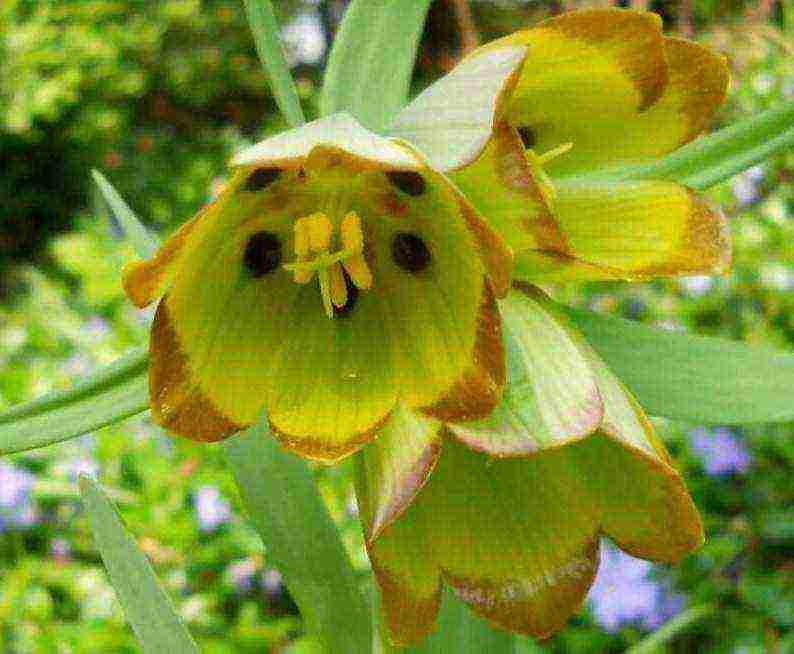 saturated green color. After flowering, "Radde" enters the dormant stage. "Radde" will respond with large and lush flowering and minimal maintenance. The variety is used for landscaping and as an addition to flower arrangements.
saturated green color. After flowering, "Radde" enters the dormant stage. "Radde" will respond with large and lush flowering and minimal maintenance. The variety is used for landscaping and as an addition to flower arrangements.
Fritillaria "Striped Beauty"
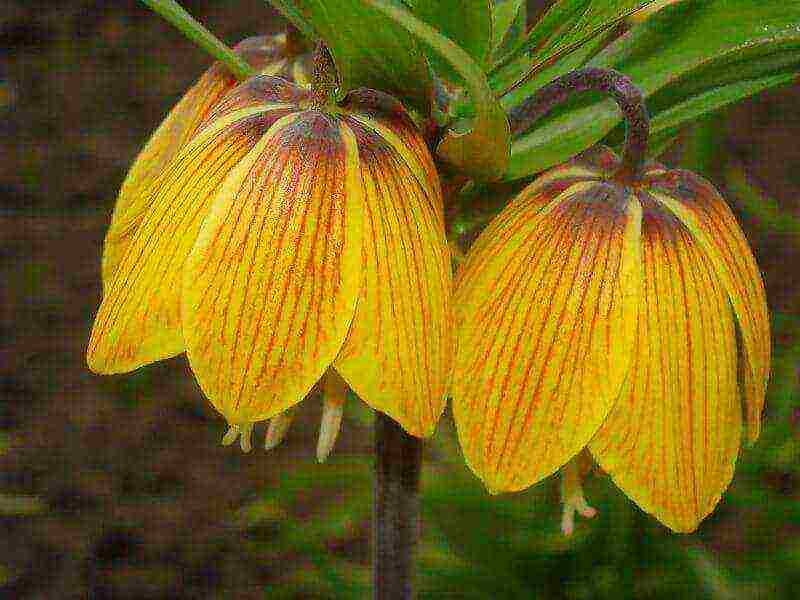 The variety is distinguished by a juicy yellow color, with numerous large veins of scarlet or burgundy color. The foliage of the plant is green, of medium length. "Striped Beauty" reaches a meter in height.
The variety is distinguished by a juicy yellow color, with numerous large veins of scarlet or burgundy color. The foliage of the plant is green, of medium length. "Striped Beauty" reaches a meter in height.
Propagated vegetatively and by seeds. It blooms colorfully, for a period of two to three weeks.
Fritillaria "Persian" (black)
Representative of the Theresia group, "Persian" fritillaria originates from Turkey and Iran. Blooms in large bells from maroon, dark blue to 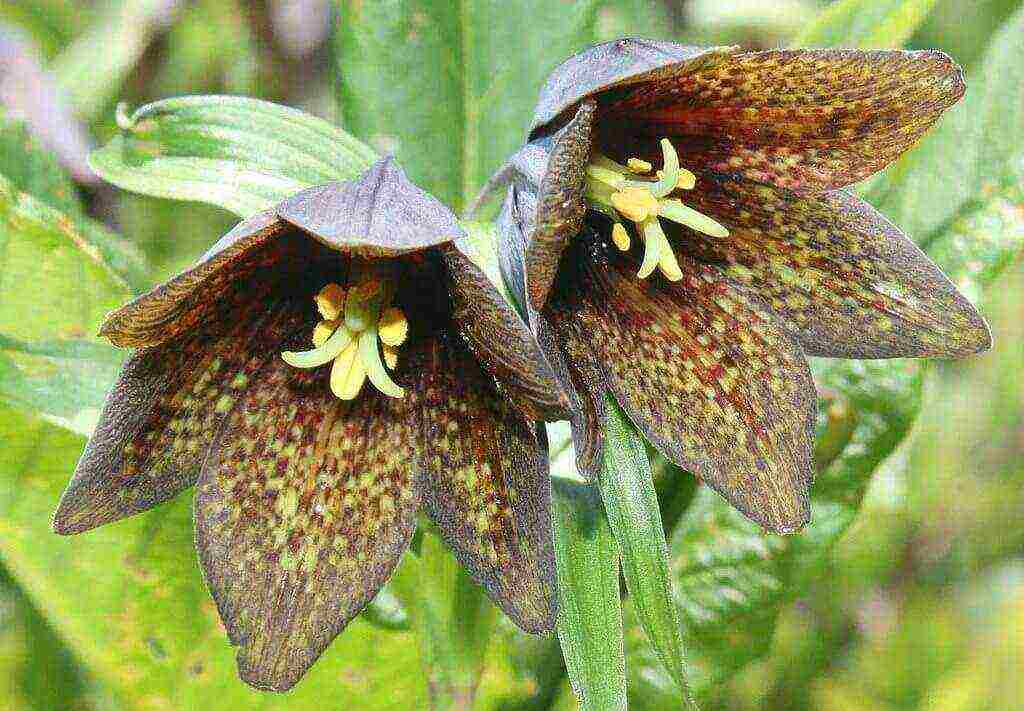 black flowers, with no less amazing bluish-green leaves. The buds are collected in a vertical cone. The height of the "Persian" fritillaria reaches 90 cm in height. One peduncle can produce up to 25 buds.
black flowers, with no less amazing bluish-green leaves. The buds are collected in a vertical cone. The height of the "Persian" fritillaria reaches 90 cm in height. One peduncle can produce up to 25 buds.
Fritillaria "William Rex"
Tall plant, with dark orange flowers and purple dusting on petals and buds. Large white stamens and dark color of the inner part of the stem of the bud. The leaves are long, thin, light green. It reproduces vegetatively, by seeds, blooms up to three weeks.
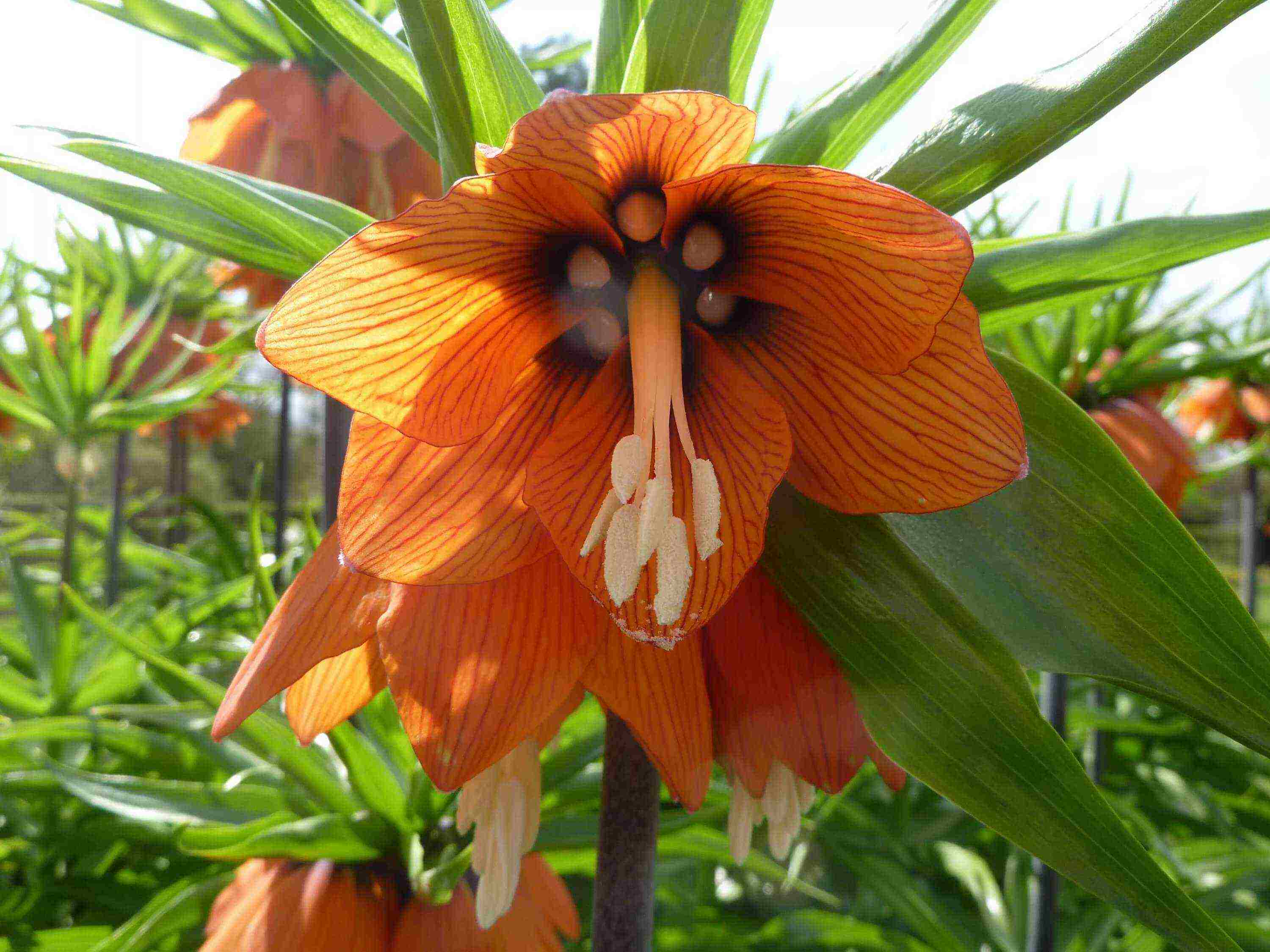 Fritillaria variety "Mikhailovsky"
Fritillaria variety "Mikhailovsky"
One of the most famous varieties of fritillaria "Mikhailovsky", unpretentious and resistant to temperature extremes, it has become a "favorite" among summer residents and professional flower growers. The plant is perennial, blooms with bright, copper-red flowers with a yellow border around the edge of the petals. The foliage is green, of medium length, narrow. The height of "Mikhailovsky" reaches 30 cm.
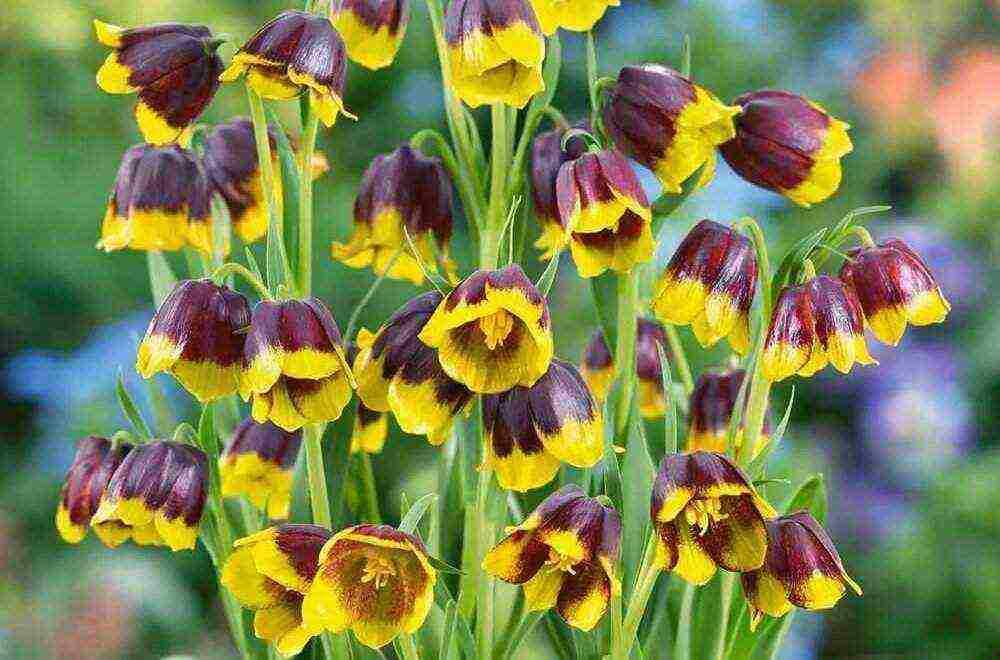 Fritillaria needle-petaled "Akmopetala"
Fritillaria needle-petaled "Akmopetala"
A beautiful variety of hazel grouse, with bells of an unusual, pale green color, and a burgundy hue inside the bud. Flowering lasts up to three weeks, abundant, with medium-sized flowers.
The variety's resistance to wintering is high. The plant is unpretentious, undersized.
Fritillaria "Raskal Bach"
The variety is distinguished by bright large copper-pink flowers. Obtained in the process of painstaking work of breeders "Raskal Bach" belongs to the small-bulbous variety of fritillaria, and, due to this, occupies smaller areas, without damaging the peduncle.
Fritillaria "Garland Star"
The "Garland Star" variety belongs to the imperial group, it is distinguished by large flowers, orange-scarlet in color, forming a large crown. The plant is large, resistant, with a thick stem and a height of about a meter.
On the above species and varieties of fritillaria, the variety of this plant does not end, there are a number of other little-known, but unusually beautiful varieties of hazel grouse.
Secrets of the lush bloom of fritillaria
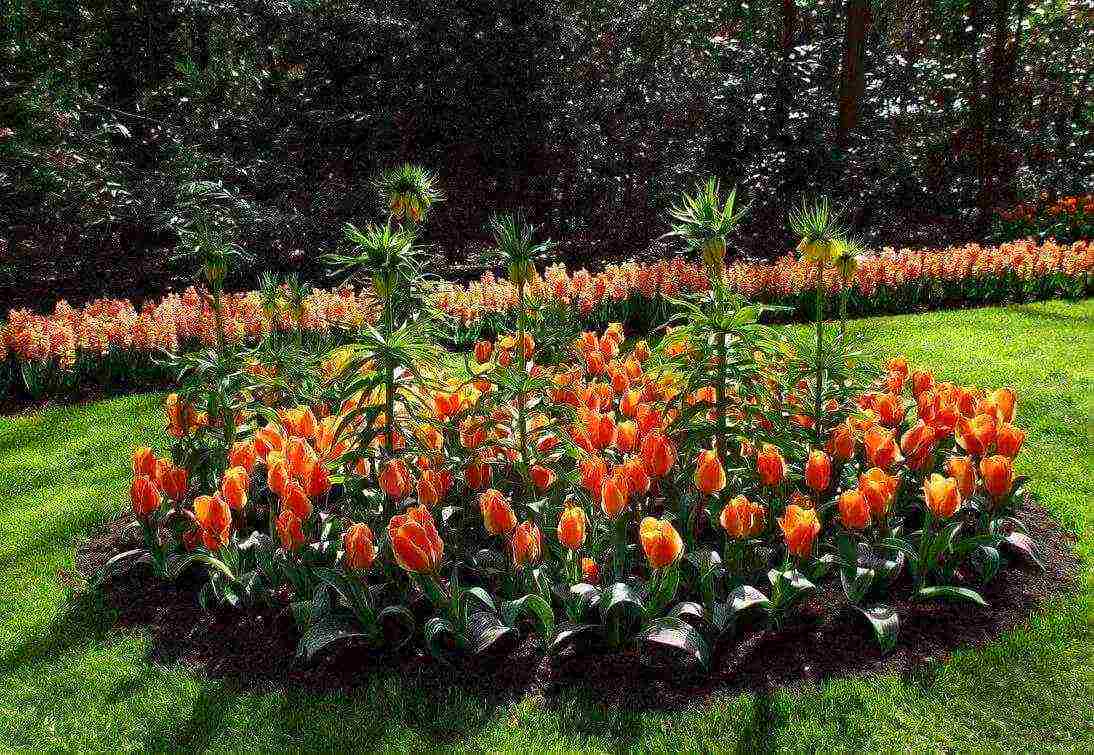 After winter sleep and warming the soil up to +12, fritillaria awakens and by the end of April it appears on the surface. Loosen the soil around the flower, remove weeds, apply phosphorus-potassium fertilizers.
After winter sleep and warming the soil up to +12, fritillaria awakens and by the end of April it appears on the surface. Loosen the soil around the flower, remove weeds, apply phosphorus-potassium fertilizers.
During the period of active growth, the hazel grouse will reach half a meter in a couple of weeks; during this period, fertilizing in the form of compost should be applied. And when the plant releases its first peduncle, apply root dressing in the form of ABA (station wagon) granules for garden flowers.
During flowering, monitor the moisture content of your fritillaria plantations and loosen the soil in a timely manner, this will saturate the plant with oxygen. Removing the seed box will increase the flowering time to 5 days.If you follow all of the above measures, fritillaria will delight you not only with lush and large flowering, but also with an unusually bright color of flowers.
Flowers Chernyaeva V.V.
|
2015-09-08 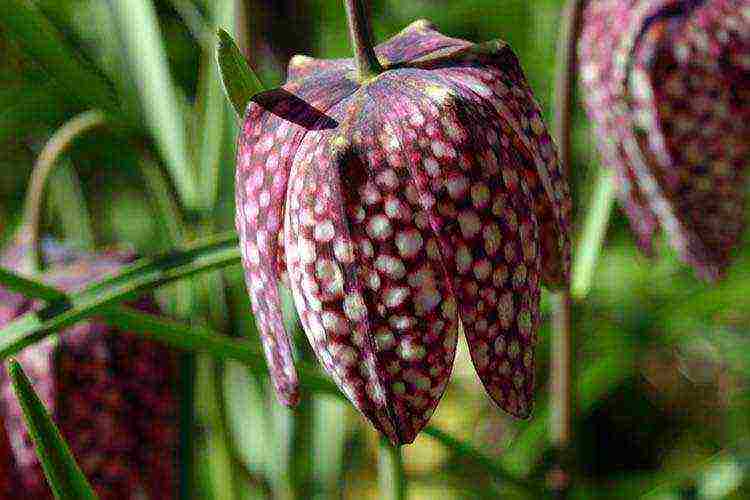
Fritillaria (popularly - hazel grouses) belong to the lily family. The name of the plant comes from the Latin word "fritilis", which means "chessboard" in Russian. This is due to the fact that some types of fritillaria have spots on the petals, located on them like a checkerboard. In total, there are currently more than 100 species of this plant.
Botanical description
Grouse are perennial bulbous plants with leafy stems, from 10 cm to 1 m in height.
The stem bears whorled or alternate leaves, from the axils of which bell-shaped flowers (white, orange, yellow, reddish, purple) hang, which are collected in racemose or umbellate inflorescences.
Fritillaria leaves perform an additional function - they collect water that has got into them and direct it to the roots. This feature is explained by the fact that the plants come from regions with low rainfall.
The growing season of fritillaria is short. The plant blooms only one month a year - in May, and spends most of its time, like a tulip, in the form of a bulb underground.
The leaves of the plant very quickly lose their decorative effect, therefore fritillaria is planted in flower beds and mixborders among peonies, lilies, phlox and other late-flowering perennials, which mask it with their leaves during this period. Not recommended cut off the stem of fritillaria, otherwise its bulb will stop growing and remain small.
Choosing a landing site
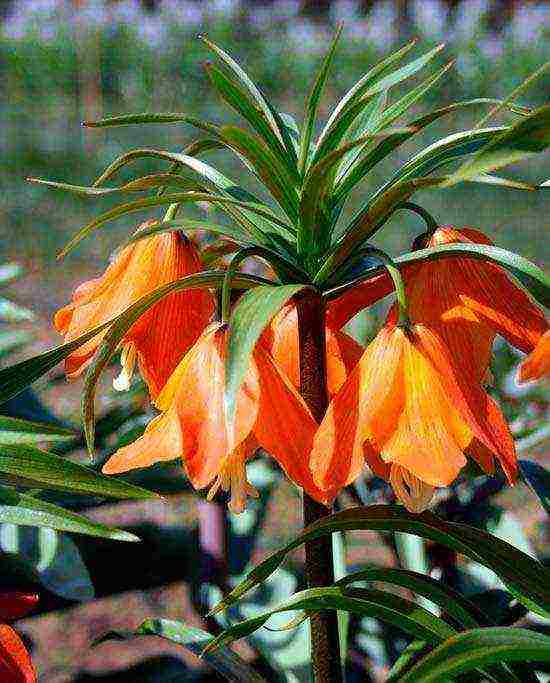
When choosing a place for planting fritillaria-hazel grouses, it should be remembered that it should be well lit (remember the alpine origin of hazel grouse), warm, drained (melt water should not stagnate), with light, loose and nutritious soil. The soil, if possible, should be well fertilized with humus, peat or rotted compost.
Plants can accept a little shading, but it is highly undesirable. In addition, hazel grouses do not like neighborhoods with large plants and tree roots.
Planting hazel grouses
The best time for planting and transplanting fritillaria-hazel grouses is the first 10-15 days of September. If you notice that the roots are starting to grow on the stored bulbs, then it's time to plant them.
Before planting, the bulbs are carefully inspected for disease and rot. Healthy bulbs are selected and, right up to planting, stored in sawdust or peat, avoiding prolonged exposure to the open air.
The planting depth of fritillaria bulbs depends on their size: large bulbs are buried by 20-25 cm, and small ones by 10-15 cm. In general, the following rule is true: the planting depth should be 2-3 times the size of the bulb. A well-buried bulb is like an anchor that keeps the plant upright throughout the growing season.
The distance between adjacent plants in a row and between rows should be at least 15-20 cm. Imperial grouse and other large-flowered varieties are planted at a distance of 40-45 cm.
Bulbs should be handled with care during planting, taking care not to damage them. After planting, it is recommended to mulch the soil around.
The need for a transplant
For hazel grouses, an annual transplant is recommended - this way they get sick less and bloom better. The transplant keeps the plants in good shape.
Young bulbs are dug up and stored in wet sand until planting, otherwise they may die. Adult bulbs are dug up 2-3 years after the aerial part has completely died out.
Care of fritillaria grouse
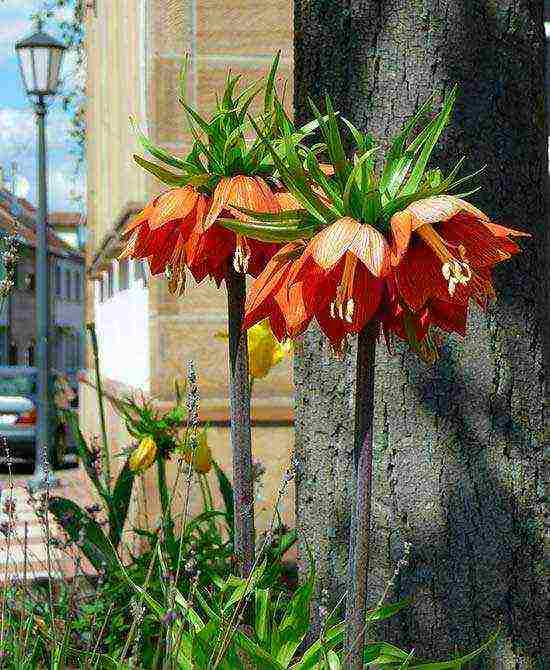
The main care for hazel grouses is watering, feeding and removing weeds. In dry, hot weather, plants need to be watered with warm water. The amount of water depends on the degree of dryness of the soil.
It is recommended to feed the hazel grouse with the help of mineral fertilizers. When feeding, do not allow the solution to get on the leaves and flowers of plants - they are sensitive and can "burn out".
When cutting fritillaria flowers for a bouquet, part of the stem and leaves must be left behind, otherwise the bulb will stop growing and die.
Reproduction
Fritillaria is propagated by seeds and baby bulbs. Seeds must be sown immediately after harvest, because during storage, they very quickly lose their germination.
Fresh fritillaria seeds give amicable shoots next spring. Seedlings are regularly watered and protected from direct sunlight. Seedlings live for 5–6 weeks, then die off, while small onions the size of a pea remain in the soil. Young bulbs are dug up and placed in a nutrient mixture. After 2 years, young bulbs of fritillaria-hazel grouse are suitable for planting in a permanent place.
Plants grown from seeds bloom in 4-7 years from the moment of planting.
Grouse in landscape design
In landscape design, the following types of fritillaria grouse are most common:
- Fritillaria Edward;
- Chess fritillaria;
- Fritillaria imperial (aka Grouse imperial);
- Fritillaria Caucasian;
- Fritillaria Kamchatka;
- Russian fritillaria and others.
Large-flowered fritillaria are used for planting in clean groups against the background of a lawn and in mixed groups with other perennials. The imperial hazel grouse and Edward's hazel grouse, which have large flowers, are indispensable in the design of reservoirs or green lawns.
Small-flowered fritillaria are good in mixborders, on rocky hills and rocky areas. For cutting, hazel grouses are used extremely rarely because of a very unpleasant smell.
Storing the bulbs
Under natural conditions, fritillaria grows in hot climates - in such conditions, the plant bulb, being underground, warms up well. In our climate, the conditions for flowering artificially created, warming up the bulb, otherwise it will not bloom. To do this, after the leaves die off, the bulb is dug out, dried and stored in a hot place with an air temperature of about +30 ° C.
Fritillaria bulbs well kept even without dry cover scales, but it is still better to store them in sawdust, sand or peat. After 50-60 days, the bulbs are transferred to a cool place, with a temperature of about +20 ° C.
During storage monitor the condition of the bulbs. If signs of drying out appear (the bulbs lose their elasticity), they are planted in the ground in the first decade of September.
Diseases and pests
Plants practically do not get sick and are not affected by pests.
If your fritillaria is sick, then the cause of the disease, most often, is improper care - decay from waterlogging, an excess of mineral fertilizers due to improper feeding, etc.
When decaying, the affected area of the bulb is cut out with a sharp knife and treated with an antiseptic.
Prevention of fritillaria diseases consists in changing the place annually and treating the bulbs with fungicides during plant transplantation.
V.V. Chernyaeva
It is difficult to imagine a more diverse genus of plants than hazel grouse. Even their traditional spring and summer rivals from among bulbous crops, despite the representative varietal and species palette, are not so “motley”. Each hazel grouse is unique in terms of flowering, preferences for growing conditions, and the required care. It is not for nothing that gardeners claim that any hazel grouse is a mystery. And it is a pleasure to guess the representatives of the hazel grouse family. Among them there are general favorites, and modest endemics, and imposing exotics. But one thing is certain - hazel grouses are never boring.
Chess hazel grouse (Fritillaria meleagris)
Mysterious and diverse fritillaria
The genus fritillaria, or hazel grouse, is one of the most difficult in all botanical classifications. Sections and subsections, disputes about species ownership, different growth conditions in nature and even more different requirements for garden soil ... When you first get acquainted with the variety of hazel grouses, it seems that you can do only one thing with them - get lost in diversity. But hazel grouses, despite various obstacles and purely scientific incidents, are very unassuming plants. And individual ones.They need a personal approach and close observation: as a rule, each hazel grouse will tell the owners how best to grow it. They got their name either for the similarity of colors with checkerboard patterns, or for the shape of flowers that look like bells (and the Russian-language name is for the similarity of variegated patterns with feathers of forest hazel grouses).
Representatives of the genus Grouse (Fritillaria) has something to boast about. Without exception, all hazel grouses are plants that adorn with flowers in the first half of the gardening season. And spring bloom is not the only common parameter for over 100 species of fritillaria. Grouse are natural insecticides, the unpleasant smell of which will not hurt in the garden, but it will help scare off some insects from among the pests. And attractive and original flowering is another common feature of them. The flowers of hazel grouse are crowned with strong stems of various bell-shaped shapes, often located under the apical narrow leaves or form fancy "crowns" with them. And the leaves of the hazel grouse are amazingly beautiful. Sharp, linear, in most species they are originally twisted in a spiral at the ends.
Among the hazel grouses there are their absolute favorites - everyone's favorites, which are ranked among the most popular garden crops. According to their characteristics, it is quite easy to navigate in the features of each of the 6 groups of hazel grouses.
Grouse (Fritillaria)
Grouse imperial (Fritillaria imperialis), which is actually called fritillaria - has already become legendary, beautifully blooming species of hazel grouse, not in vain has earned its regal name. This plant is one of the most common group of hazel grouses in landscape design - Petilium, which includes plants with large massive bulbs. In imperial hazel grouses, the height of the peduncles can reach 1.5 m, while the lower part of the shoots is densely covered with broadly lanceolate leaves, up to 10 cm wide and twice as long in length. The leafy shoots are a bit like lilies. In the upper part of the peduncle there are narrow leaves forming a "crown". Below it, the bells of flowers that look down are blooming in a circle. Tough and strong flower stalks rise from the center of the bulbs, they grow literally before our eyes: immediately after the snow melts and the start of growth, they rush upward at an amazing pace, reaching their maximum size in 2 weeks. The downward-facing buds gradually open, their arrangement on the peduncle resembles the shades on the chandeliers. Traditionally, each inflorescence consists of 6 flowers. Another unique feature of this hazel grouse: as it blooms, the bells looking downward rise, at first being located horizontally, and then completely turning up. The seed pods of this hazel grouse are equal in size to the bells themselves, they crack beautifully (but the seeds remain inside, and do not wake up).
Grouse imperial (Fritillaria imperialis)
Despite the fact that the base color of the imperial hazel grouse is brick-orange, over the long centuries of breeding this plant, many original varieties have been bred, offering to admire various shades of yellow, red, brown and orange. The best varieties of imperial hazel grouses today are:
- "Rubra" with dark red inflorescences only about 60 cm high;
- one and a half meter "Rubra Maxima" with a red color shade of Madeira;
- yellow varieties "Indora", "Lutea" and "Maxima Lutea";
- golden-orange grade "Prolifera".
The Petilium group also includes other large hazel grouses with densely leafy shoots and apical inflorescences-wreaths of bell-shaped flowers, crowned with a bunch of leaves:
Grouse Radde (Fritillaria raddeana)
Grouse Radde (Fritillaria raddeana) - hazel grouse up to 80 cm high with dark lanceolate leaves and large, broadly bell-shaped, pale yellow or cream flowers in loose clusters of inflorescences, in which all flowers look in different directions. This hazel grouse wakes up early, endures late frosts, miraculously thawing after icing, but blooms only in early May;
Spectacular orange-colored Grouse Edward (Fritillaria eduardii) is a perennial about 1 m high, with densely leafy powerful stems and umbrella-shaped inflorescences, consisting of an upper bundle of leaves and bell-shaped flowers up to 6 cm in diameter directed to the sides.
Edward's hazel grouse (Fritillaria eduardii)
The most numerous group of hazel grouses, Eufritillaria, uniting hazel grouses with a sparsely leafy stem, flattened medium-sized bulbs and few bell-shaped flowers at the tops of the shoots, also have their favorites.
Grouse Mikhailovsky (Fritillaria michailovskyi) is one of the most beautiful two-colored hazel grouses. Bluish narrow leaves and thin peduncles emphasize the beauty of single, wide bell flowers with a dark burgundy color, which contrasts with the yellow border. The flowers of this hazel grouse look like variegated "skirts".
Grouse Mikhailovsky (Fritillaria michailovskyi)
Hazel grouse, or Grouse variegated (Fritillaria meleagris) is a beautiful plant from 20 to 40 cm in height with a slightly leafy stem, crowned with an inflorescence of drooping bell flowers. Regardless of the basic color of the petals, this hazel grouse is easy to recognize: the specks are sometimes almost square in shape, dark, brown-violet, give the plant variegation and graphicity. The whimsical magic of the bells blooming relentlessly and the delicate, delicate bluish leaves are truly impressive in any arrangement. Chess hazel grouses bloom in April or May, and grow in full sun and partial shade. In addition to the basic form, that hazel grouse has many attractive varieties:
- the snow-white form of Alba;
- the purple-green Artemius variety, whose designs resemble snakeskin;
- white-green variety "Aphrodite"
- almost black variety "Charon";
- dark purple Mars variety;
- large, dark red with a catchy pattern "Jupiter";
- white-purple variety "Poseidon";
- pink-flowered variety "Pink Eveline" with a bright checkerboard pattern;
- red-violet with light spots "Saturn";
- violet-purple with light specks "Orion", etc.
Grouse chess, or Grouse variegated (Fritillaria meleagris)
Hazel grouse, or Hazel grouse (Fritillaria pallidiflora) - a taller half-meter species with a densely leafy stem and a white or light yellow inflorescence with a light green tint, consisting of 10-12 bells. It is a sun-loving and gentle plant.
Grouse pallidum, or Grouse pallidum (Fritillaria pallidiflora)
You should also pay attention to:
- half-meter Hazel grouse (Fritillaria acmopetala) with narrow pale leaves, two-centimeter green-burgundy bells hanging in pairs at the tops of the stems;
- reaching 40-50 cm in height, sizolytic Elwes' hazel grouse (Fritillaria elwesii) with purple, green-streaked, elongated flowers and slightly lower;
- with green-purple stripes on the flowers Hazel grouse (Fritillaria hermonis);
- like him Grouse Earhart (Fritillaria ehrhartii) with eggplant purple flowers;
- unique Grouse Davis (Fritillaria davisii) - only about 15 cm high with waxy, elegantly shaped flowers, whimsically iridescent in all shades of purple and brown, and a similar Greek hazel grouse (fritillaria graeca Boiss. & Spruner), in which the petals are decorated with a central green vein;
- dwarf, up to 15 cm in height Hazel grouse (Fritillaria aurea) with golden yellow flowers covered with an orange checkerboard pattern;
- medium-sized, with green flowers with a brown checkered pattern Grouse Whittola (Fritillaria whittallii);
- fast-growing, easily adaptable Hazel grouse, or Hazel grouse, or Hazel grouse (Fritillaria involucrata) with green bells of flowers covered with brown spots;
- jade low Grouse Gusikh (Fritillaria gussichiae) with caramel spots inside the corolla;
- unique bronze appearance Hazel grouse, orHazel grouse (Fritillaria pyrenaica) with bronze bells covered with golden spots, hiding a golden motley pharynx;
- spotted yellow-orange Hazel grouse yellow (Fritillaria lutea). Currently, there is no clear classification of this species in taxonomy;
- just as low, but with cap-like jade green bells with a yellow edge Grouse Vifinsky (Fritillaria bithynica);
- tiny, broad-leaved, with dense foliage and brown-green speckled broadly bell-shaped flowers Grouse thick-leaved Kurdish variety (Fritillaria crassifolia subsp.poluninii);
- flaunting with a unique cherry-ink color Hazel grouse, up to 20 cm high with unusual tulip-shaped leaves (Fritillaria latifolia);
- half-meter, with contrasting checkerboard patterns on large bells of greenish-purple flowers, Hazel grouse, or Hazel grouse (Fritillaria orientalis);
- offering to admire the contrast of the dark brown color of the outer side of the petals and the olive on the inside, Hazel grouse assyrian (Fritillaria assyriaca);
- high, up to 1 m Hazel grouse, or Hazel grouse, or Hazel grouse (Fritillaria meleagroides) with long drooping leaves and dark, red-brown flowers, decorated with an obscure variegated pattern and yellowish tips of the petals;
- graceful and touching, with single flowers on thin peduncles and bright leaves Hazel grouse (Fritillaria caucasica) with a unique bluish-purple color;
- reaching 80 cm in height with brown-purple "patterned" flowers Hazel grouse (Fritillaria montana).
Grouse grouse (Fritillaria acmopetala)
Profusely flowering hazel grouses growing from lily-like scaly bulbs are grouped into the Liliarhyza group. It includes:
- Hazel grouse related (Fritillaria affinis) with large inflorescences of bell-shaped flowers with an unstable, yellow-purple color;
- motley Grouse two-flowered (Fritillaria biflora) with miniature but numerous flowers of a chocolate brown color with light spots and an emerald stripe on the outside of the petals;
- forest Hazel grouse (Fritillaria camschatcensis) up to 60 cm high with triangular leaves located in whorls along the stem and purple or bronze, with a bright pattern inside funnel-shaped flowers;
- Hazel grouse (Fritillaria pudica) up to 30 cm high with hanging orange-solar bells of flowers;
- Grouse Maksimovich (Fritillaria maximowiczii) up to 40 cm high with linear leaves and single, large lilac-green flowers;
- bright yellow, with almost invisible specks on the outside and brown checkerboard inside the flowers Hazel grouse (Fritillaria glauca);
- dwarf Hazel grouse david (Fritillaria davidii) with a brownish-red flower.
Grouse Kamchatka (Fritillaria camschatcensis)
Hazel grouse (Fritillaria persica) is the only species included in the Theresia group. It is a tall, large and very graceful species about 1 m high with a rare pyramidal inflorescence, consisting of 20-30 bell-shaped drooping flowers, similar to small bells. The plant seems to be a graceful drop on flower beds. In addition to the basic form with a dark purple color, there are also Persian hazel grouses with light green, cream, brown colors, and even with two-tone combinations.
Persian hazel grouse (Fritillaria persica)
A rare, but no less beautiful group of hazel grouses - Rhinopetalum. It combines hazel grouses with an unusual shape of flowers directed downward, with translucent petals, a lily-shaped shape and rare monochromatic colors. This group includes:
- light pink Grouse arian (Fritillaria ariana);
- showy, with soft pink flowers and pubescent stem Hazel grouse (Fritillaria stenanthera);
- blue-white, with actiniform flowers Grouse Bukhara (Fritillaria bucharica);
- surprisingly showy, lily-like pink-white Grouse Karelina (Fritillaria karelinii).
Grouse Karelin (Fritillaria karelinii)
To the genus of hazel grouse are ranked and Korolkovia Severtsov, or Grouse Severtsova (Fritillaria sewerzowii) - a plant with fuchsia-like flowers of yellow-brown color, very elegant and wide leaves, which seems gloomy and beautiful at the same time.
Korolkovia Severtsova, or Grouse Severtsova (Fritillaria sewerzowii)
In the design of the garden, hazel grouses use:
- for setting touching spring accents - in groups that imitate small natural clusters;
- in flower beds and mixborders with continuous flowering;
- on large flower beds and ridges with partners, who will then hide empty spaces;
- small dense spots on the lawn or to decorate groups of shrubs and woody;
- as a spring landscape accent;
- in rockeries, at the foot of rock gardens as piece accents;
- in pots and containers;
- grown for cutting.
Grouse mountain (Fritillaria montana)
Best partners for hazel grouses: daffodils, tulips, anemones, muscari, other spring bulbs.
The golden rule of growing any hazel grouse
Whatever fritillaria - rare and wild or varietal and known to all - you did not come across, remember one thing: this plant needs an individual approach. When buying a hazel grouse, be sure to check the growing parameters for a particular plant that fell into your hands. Feel free to ask if it needs any special conditions, what kind of lighting and soil the plant is used to and how it was looked after. After all, if the hazel grouse is "accustomed" to constant watering, top dressing and grew on specially improved soil, in any other conditions it will no longer settle. Despite the discrepancy in natural habitats, sizes and nature of plants, most hazel grouses are very similar to each other. But the basic preferences of hazel grouses are not as important as the conditions to which specific specimens are accustomed. The best strategy for growing hazel grouses is to fulfill the basic requirements and observe the plant without interfering with its development for several years. The hazel grouse do not like excessive care, constant intervention and themselves will tell you how best to change conditions or what kind of care they need.
Grouse golden (Fritillaria aurea)
Conditions for hazel grouses
Despite the love for an individual approach, all hazel grouses have minimum requirements for the characteristics of growing conditions. So, all plants from this genus do not like strong shading. Only some species of hazel grouse prefer partial shade, most - sun-loving crops. When choosing a location for a hazel grouse, consider the preferences of a particular species, but stay in warm, sunny or slightly shaded locations.
The same basic characteristics can be distinguished for soils. The hazel grouses cannot stand water stagnation and waterlogging, and the soil for them should always be loose, water and air permeable. Even rare species of hazel grouse can bloom beautifully only on fertile soil. Therefore, for representatives of fritillaria, choose high-quality garden soil. In terms of structure, it is better to prefer a sandy-clay substrate, fresh and moist, but not soggy.
Grouse narrow anthered (Fritillaria stenanthera)
Digging and planting hazel grouses
Planting of rowers in the ground is carried out only after signs of growth begin to appear on the bulbs - roots. Usually this process takes place in August-September. Later than the second decade of September, hazel grouses cannot be planted: the bulbs simply cannot root normally for successful wintering.
Planting hazel grouses is quite specific. A handful of wood ash, a layer of peat and sand must be laid at the bottom of the planting pits, and the removed soil is mixed with sand, compost, fertilizers to improve its characteristics and structure. The bulbs should not be placed superficially or to a depth equal to 2-3 times the height of the bulbs, but 15-20 cm from the ground line. A distance of 15 to 25 cm is left between the bulbs. When installing the bulbs, care must be taken that they are not straight, but at a very slight slope, sufficient to avoid water entering the hollow ends of the bulbs.
After the hazel grouses complete their flowering, the plant bulbs are dug up, dried in the shade (preventing them from withering) and stored in the premises. Digging can be carried out both annually and with a frequency of 2, and even 3 years, but the latter option can negatively affect the decorative flowering of varietal hybrids. Today, most hazel grouses are recommended to be grown with a digging for every second year, which allows not only to observe more powerful flowering, but also to get larger and stronger daughter bulbs. If small, young bulbs are planted, then for 2-3 years it is better not to interfere in their development in any way.
Unlike tulips and other bulbs, hazel grouses prefer storage temperatures above 18 degrees Celsius.And the bulbs themselves are covered with sawdust or placed in paper bags. Some gardeners argue that for the luxurious flowering of hazel grouses, it is better to keep the bulbs at an air temperature of about 30 degrees. The bulbs must be constantly inspected and, at the slightest sign of decay, cut out the damaged parts, sprinkling the cuts with charcoal. The minimum storage time outside the soil is 2 months.
Features of caring for hazel grouses
The dislike of excessive moisture dictates the watering strategy. Most hazel grouses can do without them. But these plants will bloom beautifully only if they compensate for the spring drought. Watering should be moderate, restrained, only corrective, in no case frequent. For hazel grouses, waterlogging of the soil even during a single procedure is unacceptable.
In order for the flowering of hazel grouses to be spectacular, and the bulbs to ripen well, you need to take care of another important factor - maintaining a stable soil nutritional value. For hazel grouses, even the largest and varietal ones, you need to make two additional dressings:
- at the stage of budding;
- after flowering is complete.
Fritillaria pudica
For hazel grouses, you can use full mineral fertilizers (or replace the second feeding with a phosphorus-potassium mixture), and organic fertilizers (with the exception of manure).
One of the main features of hazel grouse is the prohibition of any interference with the development of the plant until the leaves wilt. The hazel grouses should not be rushed or dug out before the above-ground parts of the plant die off on their own.
Before winter, conditions for hazel grouses need to be stabilized - to compensate for snowless periods and temperature drops during thaws. To do this, it is enough to carry out mulching with dry foliage or cover the plantings with spruce branches.
Diseases and pests
Grouse, like most bulbous, are quite resistant to fungal diseases. But pests are often attracted by their foliage and bulbs. Leaf beetles, slugs, snails, wireworms eat up the plant quickly enough and the fight against them should be started as early as possible (control measures should be comprehensive - insecticides and traps).
In order to prevent possible problems in the development of hazel grouses, it is better to adhere to the rules of crop rotation (crop rotation), not to plant these plants in places where other hazel grouses or bulbs grew.
Grouse imperial (Fritillaria imperialis)
Reproduction of hazel grouse
Like all bulbs, hazel grouses are easily propagated by daughter root bulbs. During digging for a dormant period outside the soil, small daughter bulbs are separated from the mother plants, which are then used as independent specimens. In hazel grouses, small children are very easily separated from the mother bulb, often they cannot be completely removed from the soil and they themselves will sprout next year.
Can be propagated by hazel grouses and seeds. They are sown in August or September and freshness is critical. The beds for sowing must be prepared in advance, and the seeds themselves are rarely scattered into neat grooves about 1 cm deep.After sowing, the planting is mulched with peat with a layer of about 2 cm.After the leaf appears in spring, the plant must be carefully grown, protecting it from getting wet throughout the first year. It is possible to dig up newly formed bulbs to protect against wet summer only in the second year.

